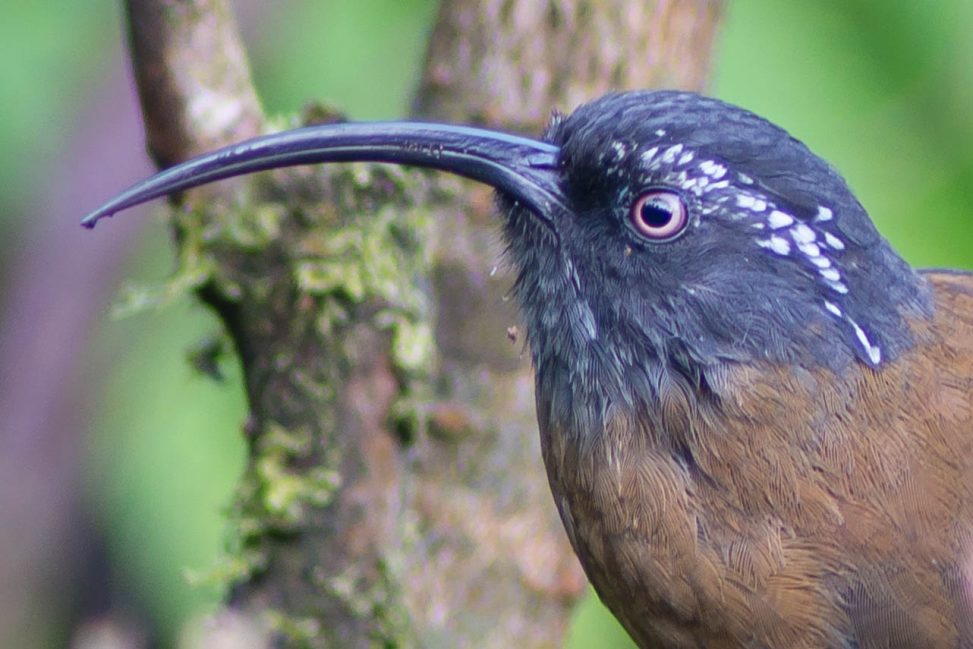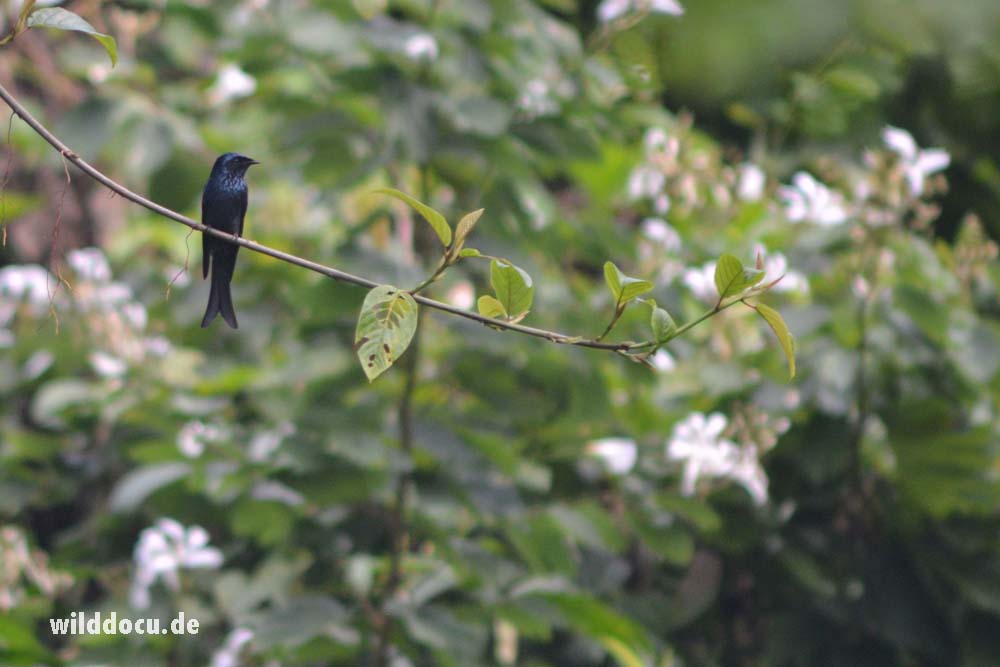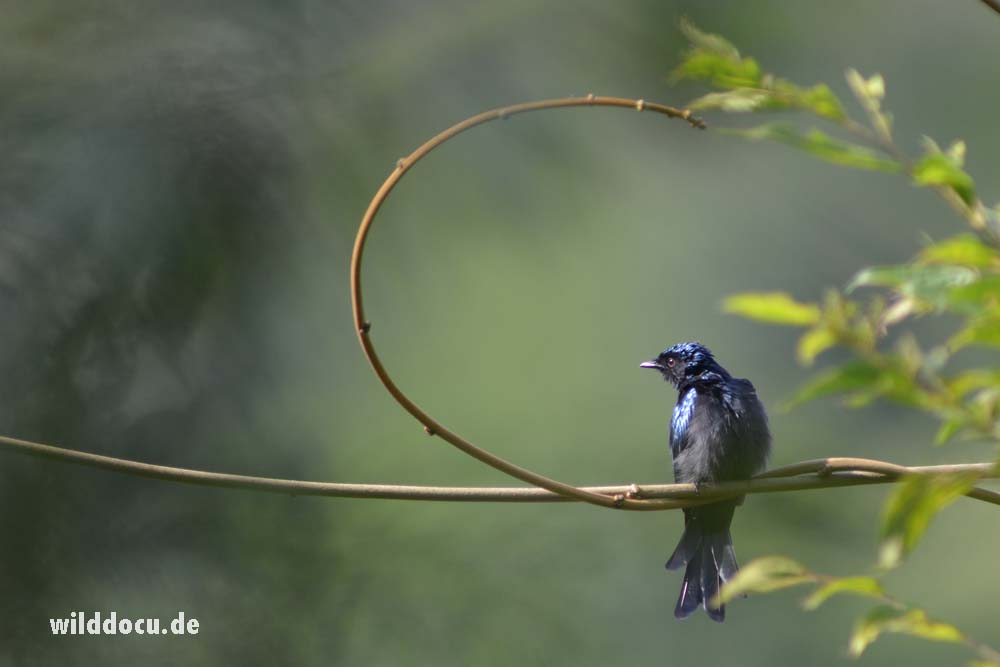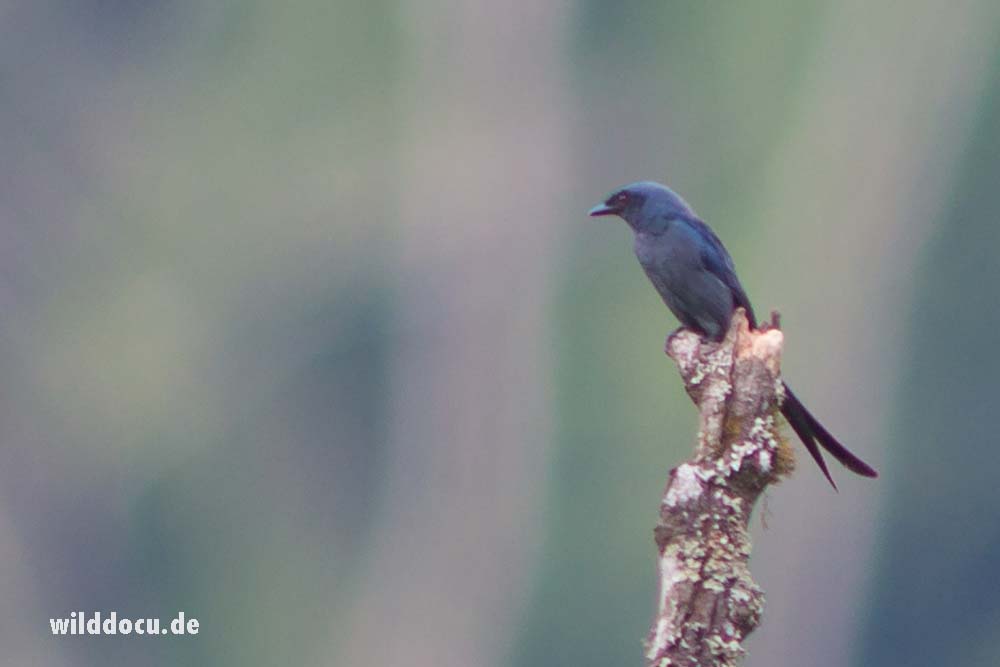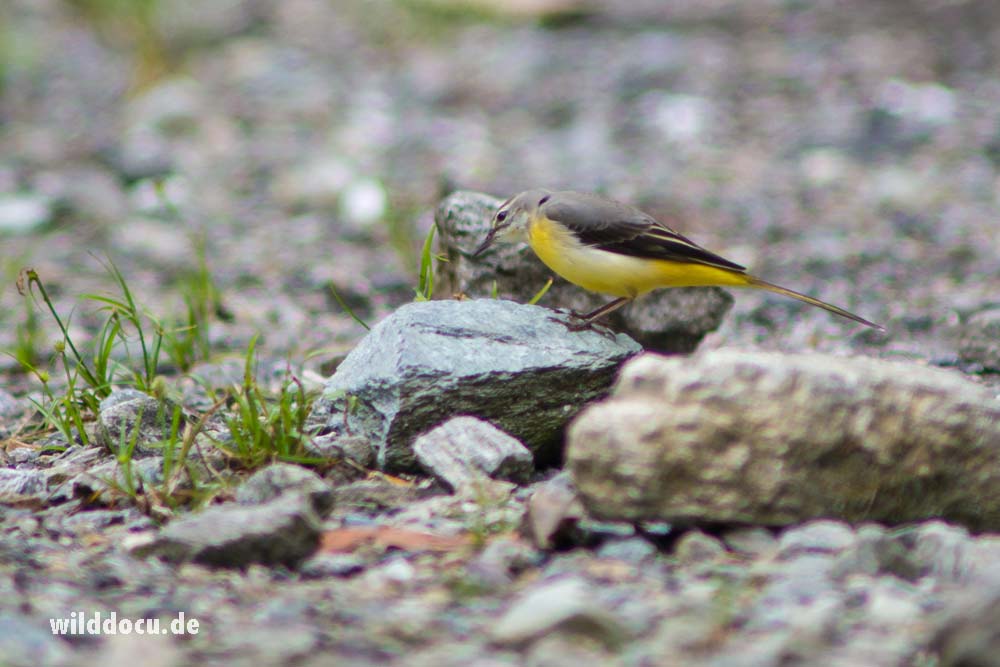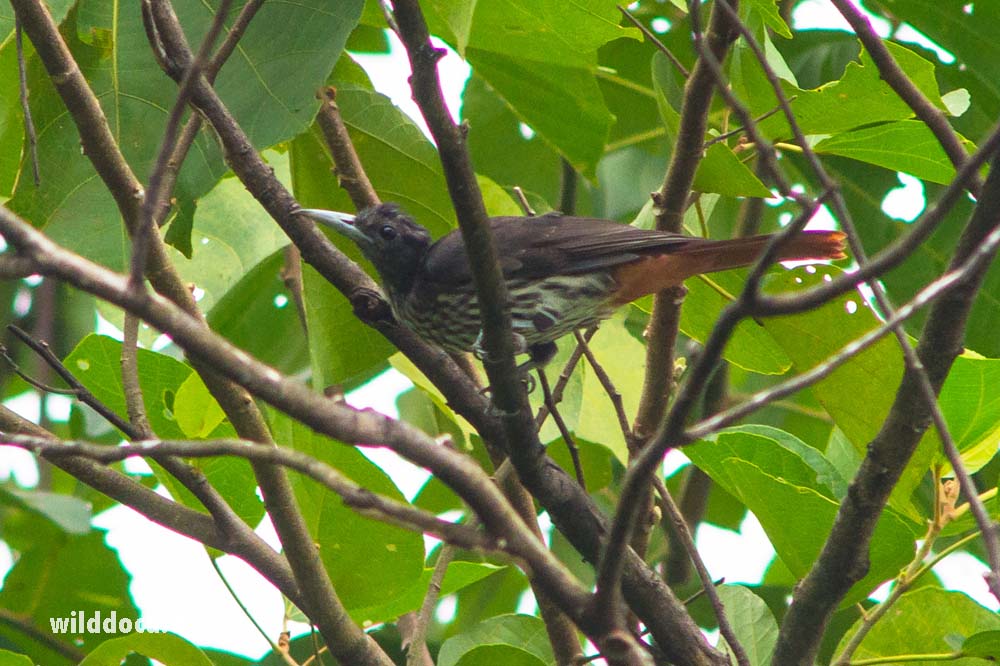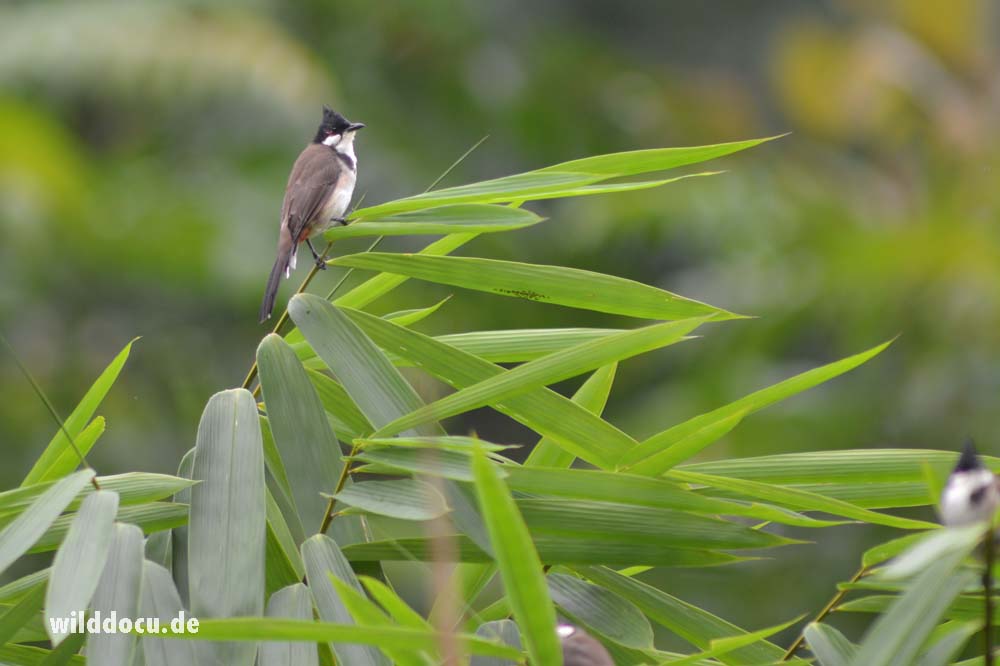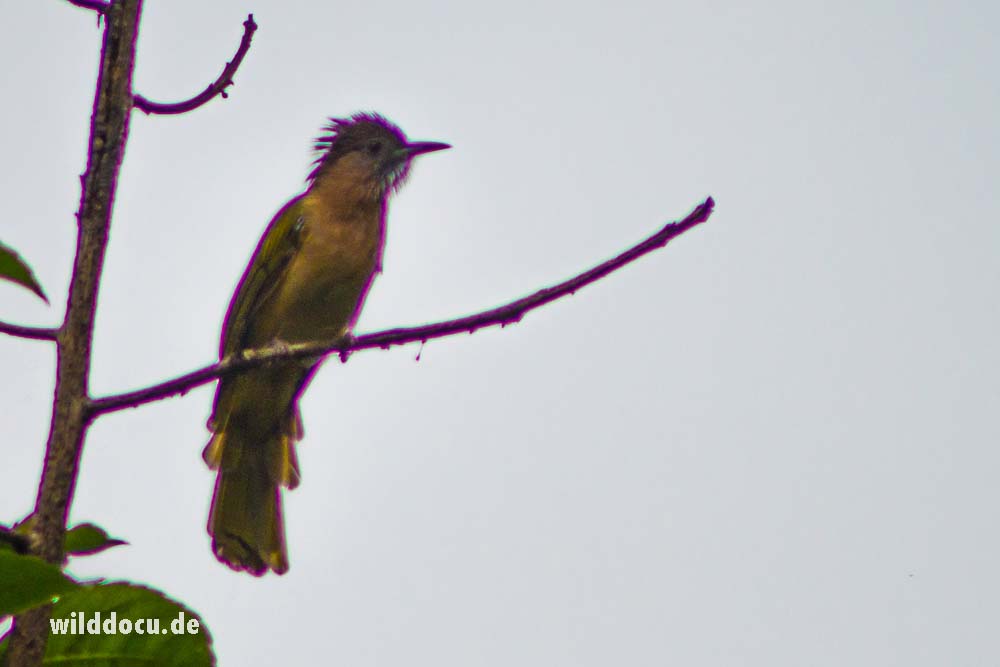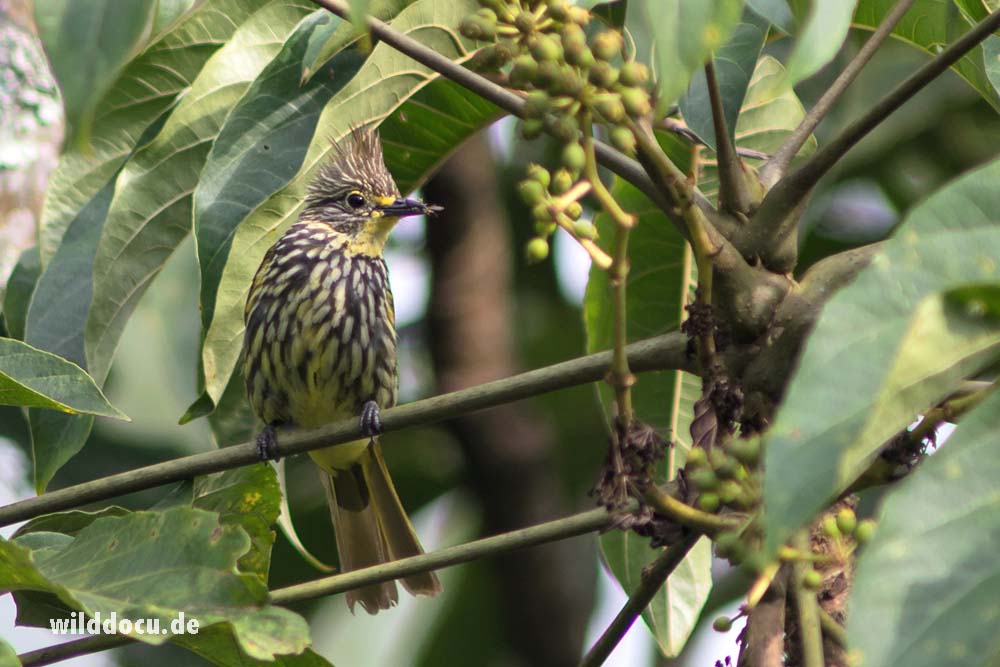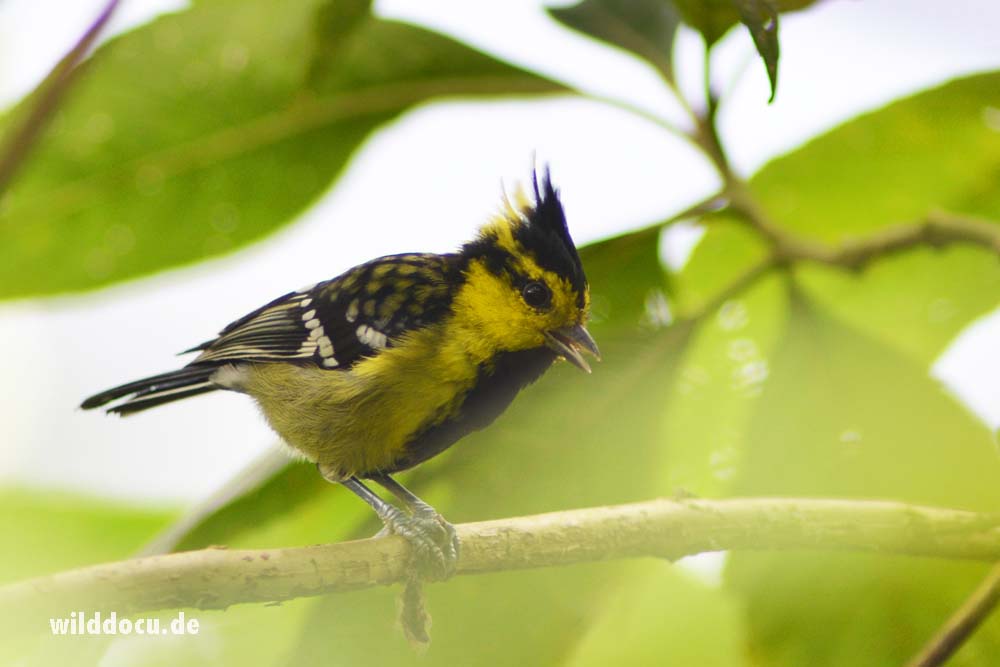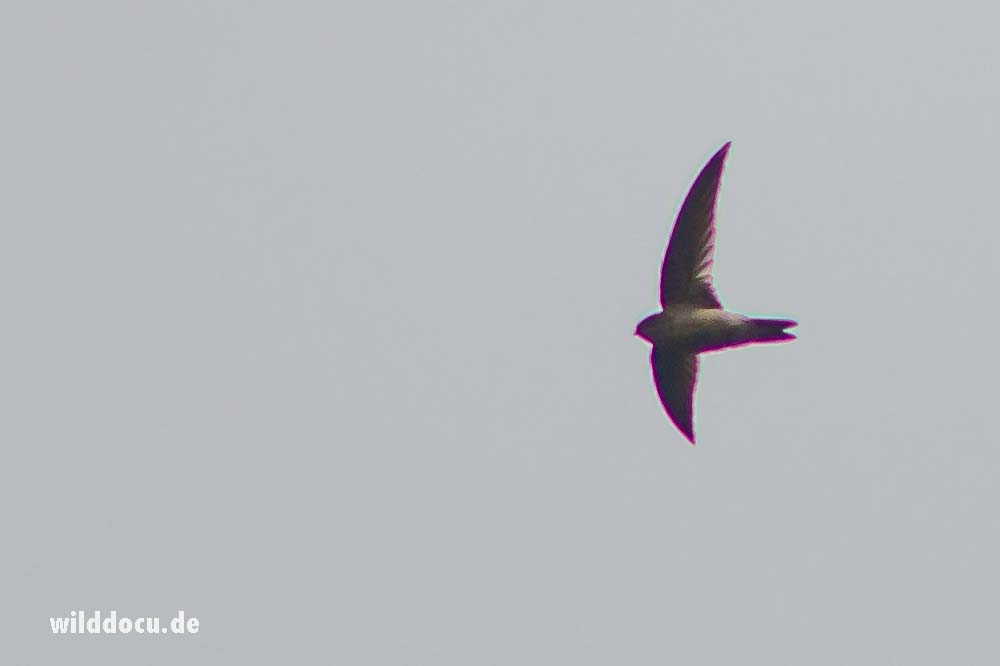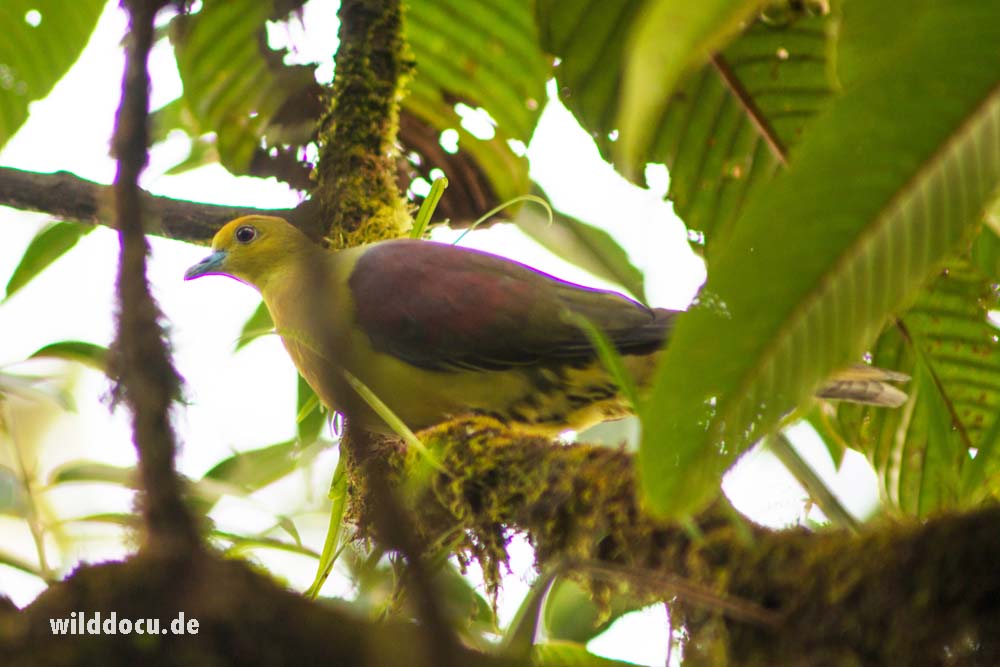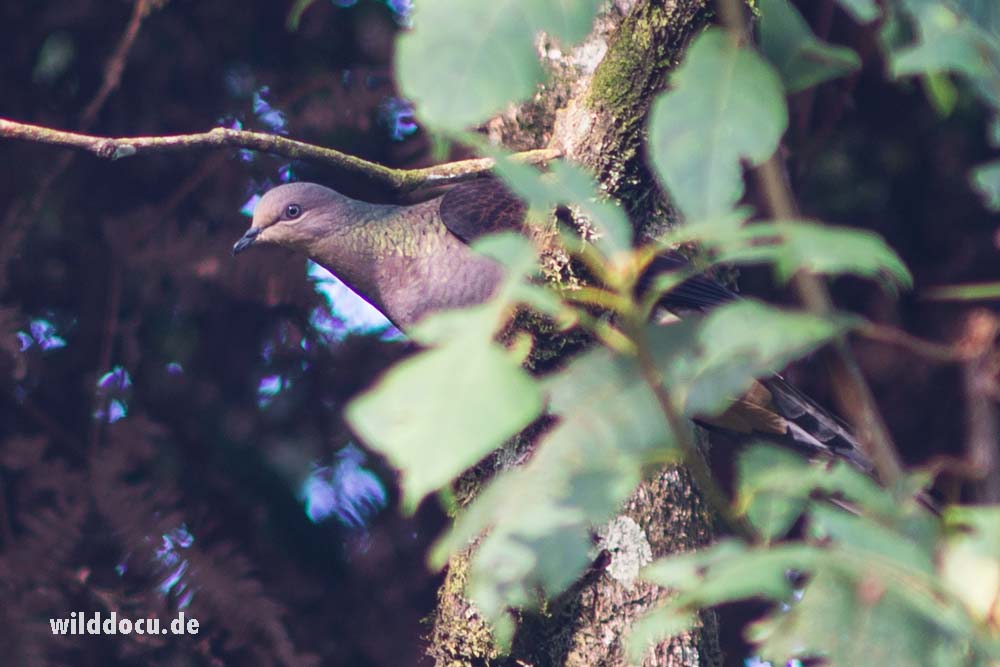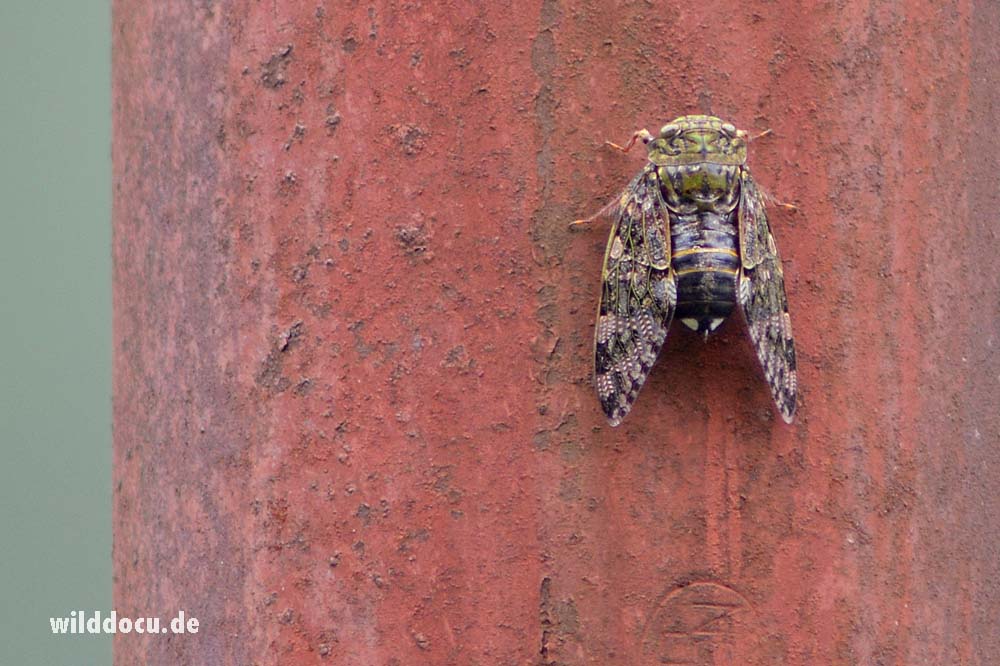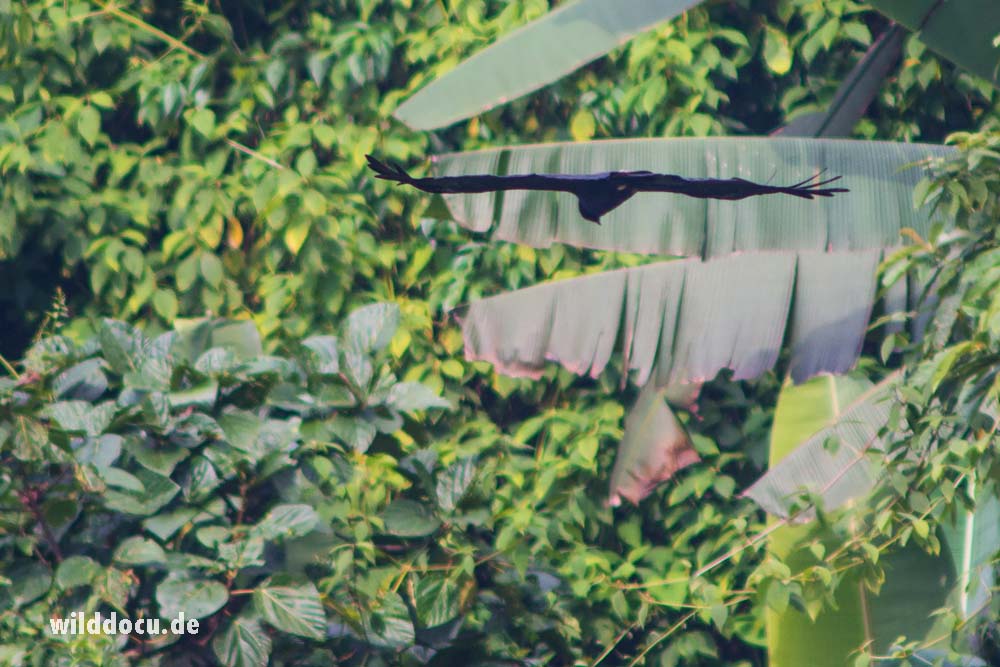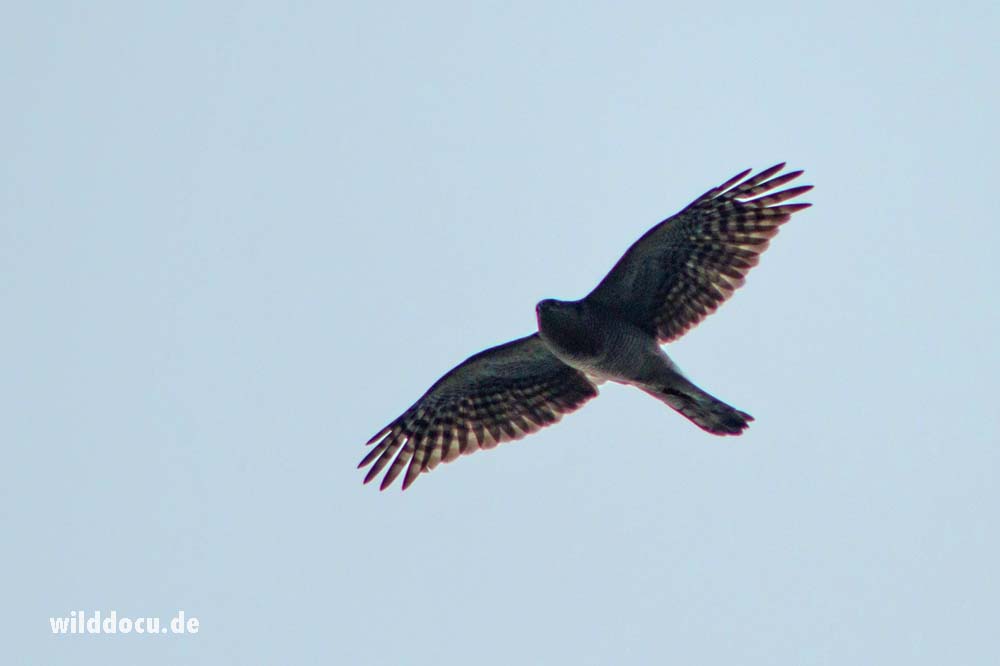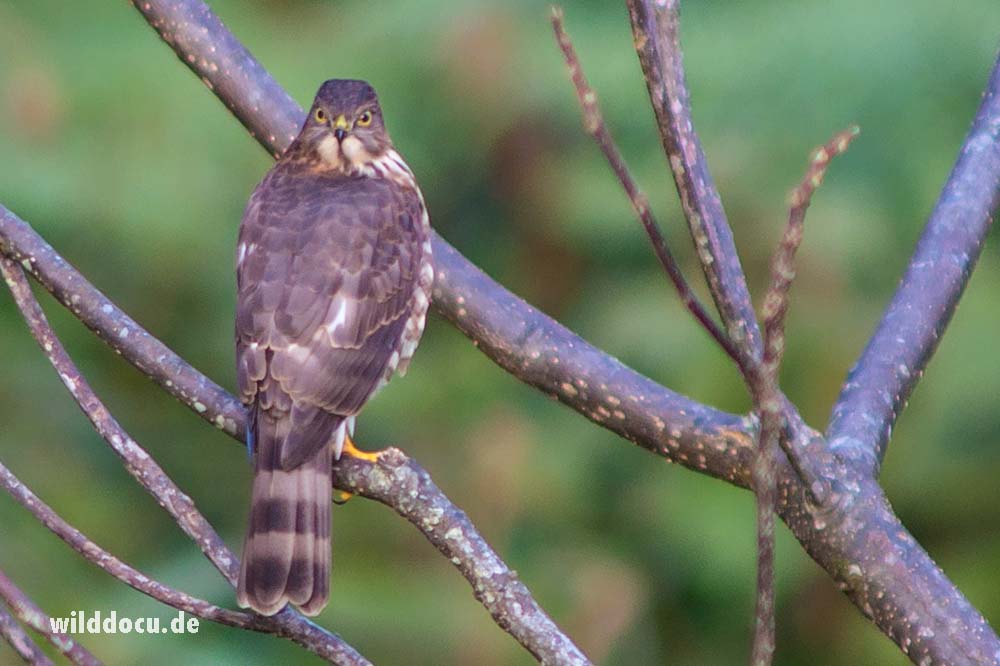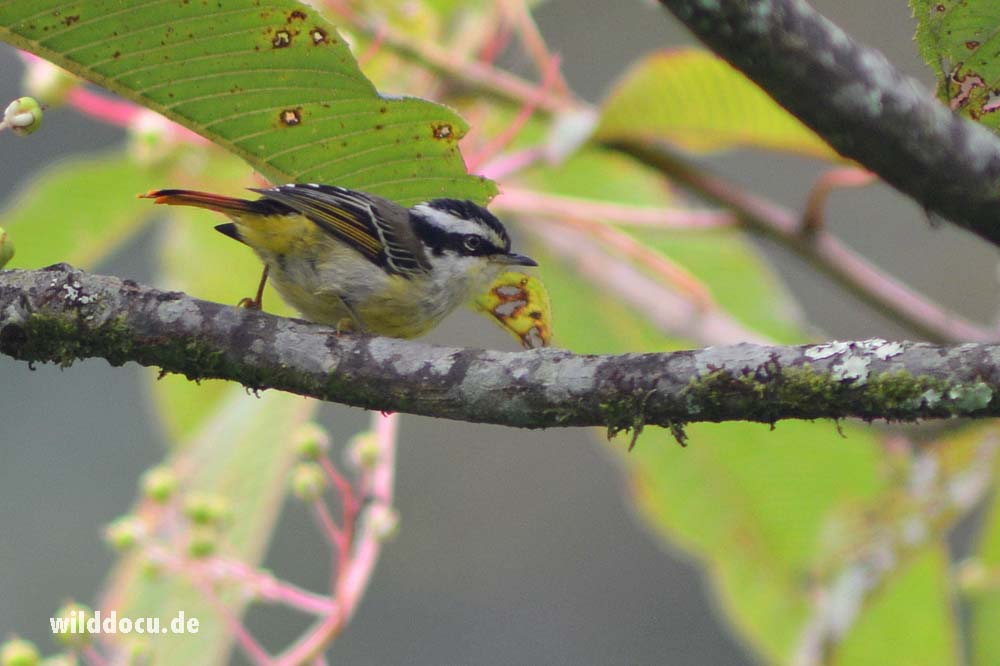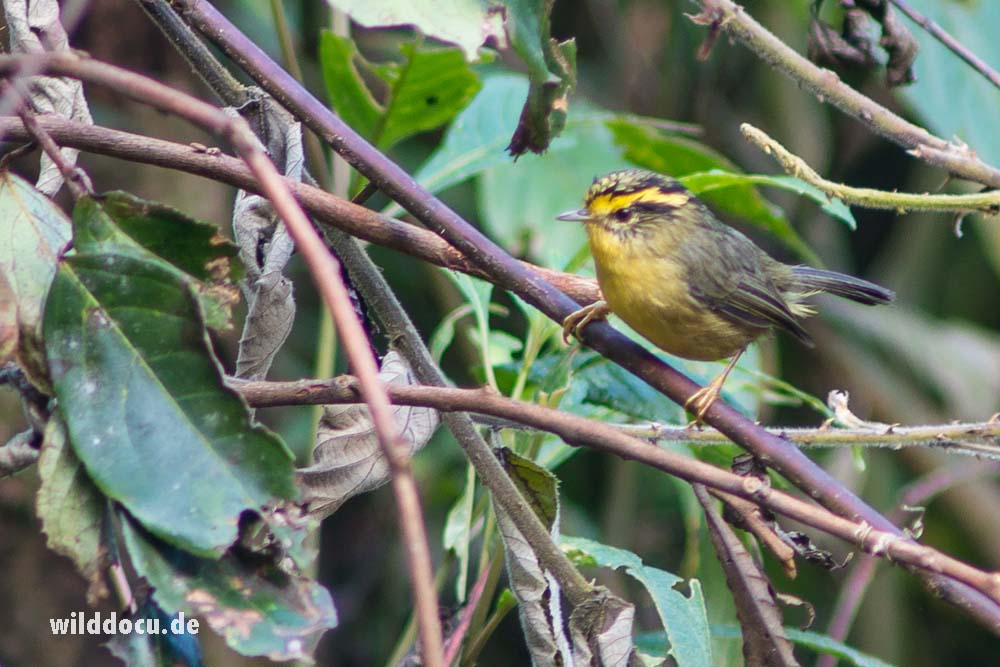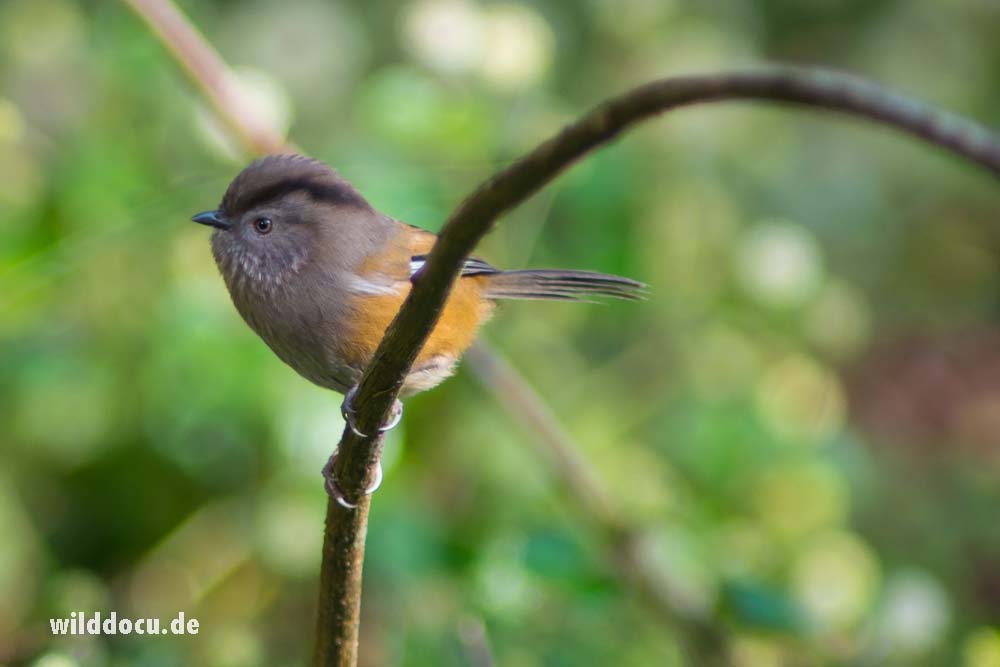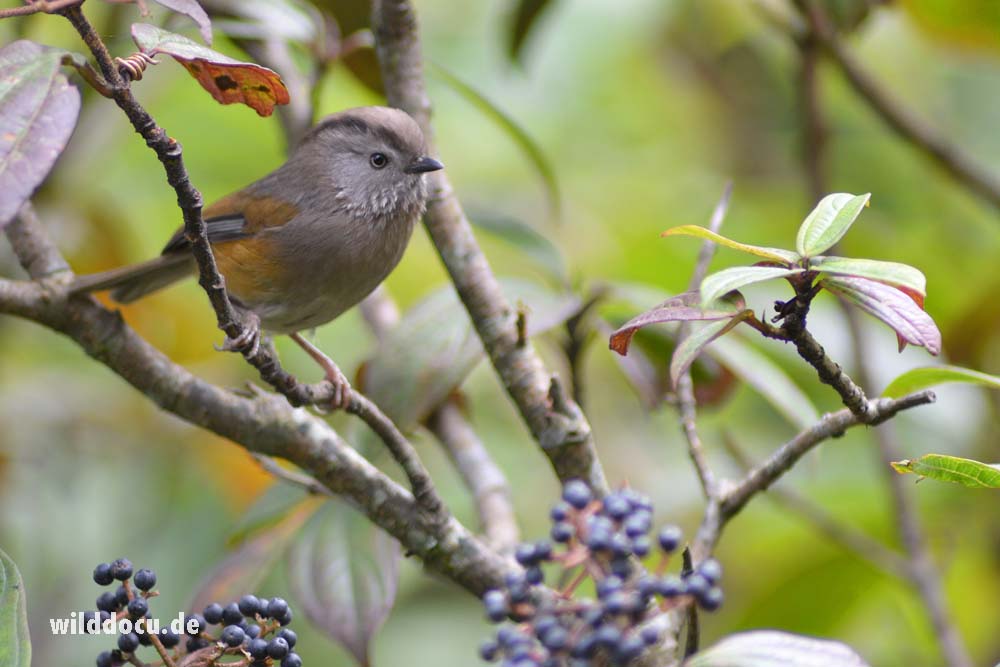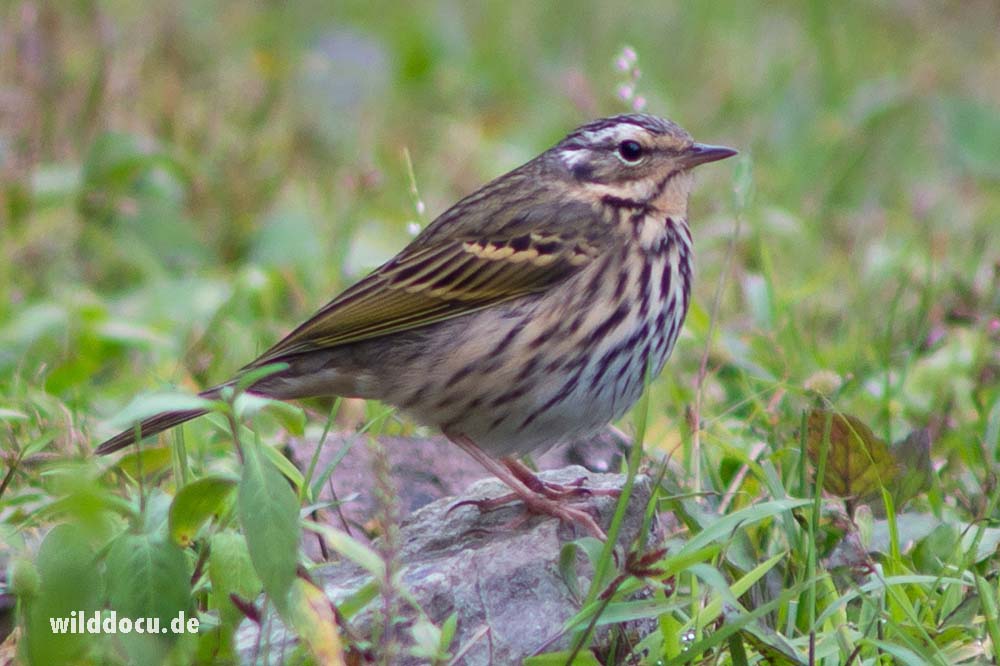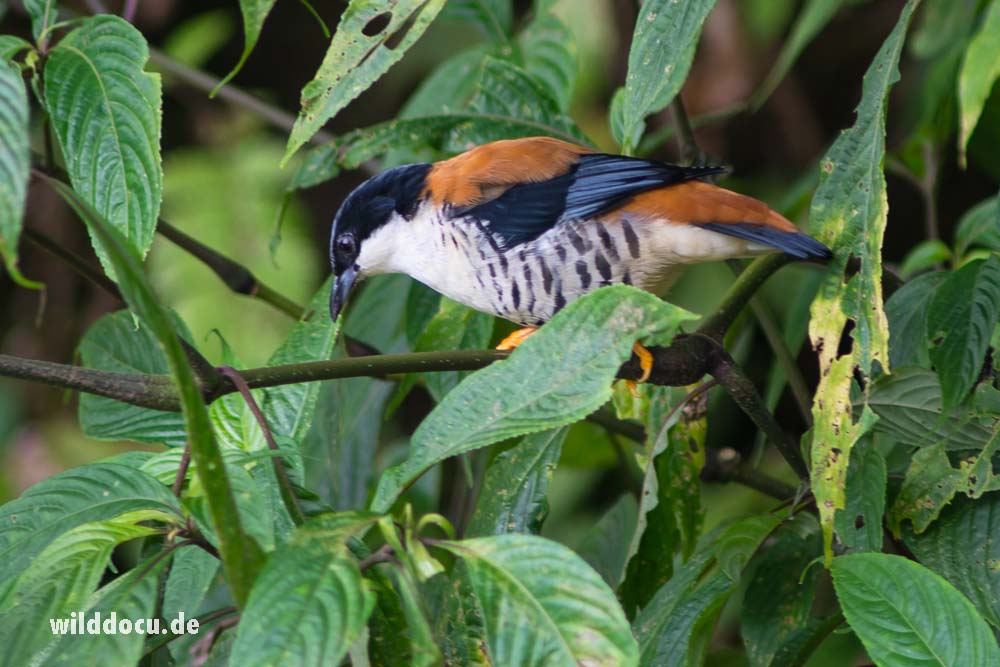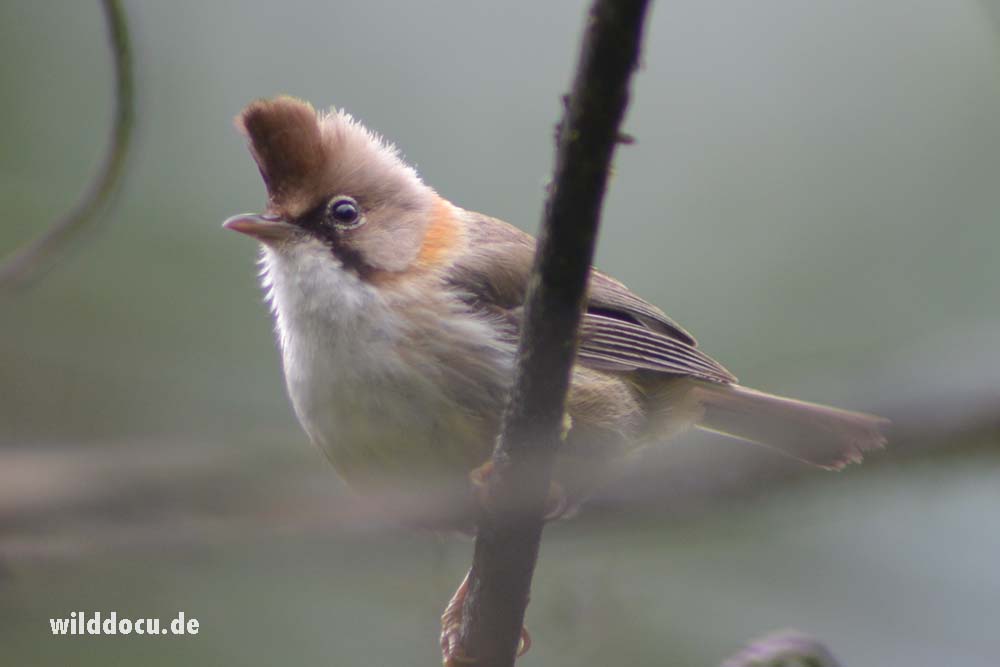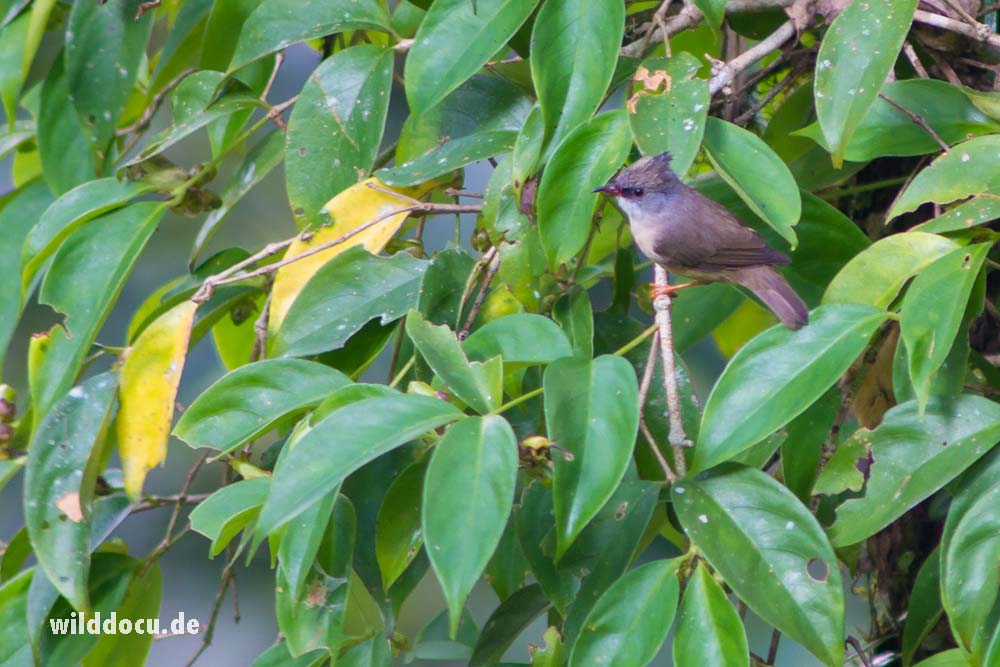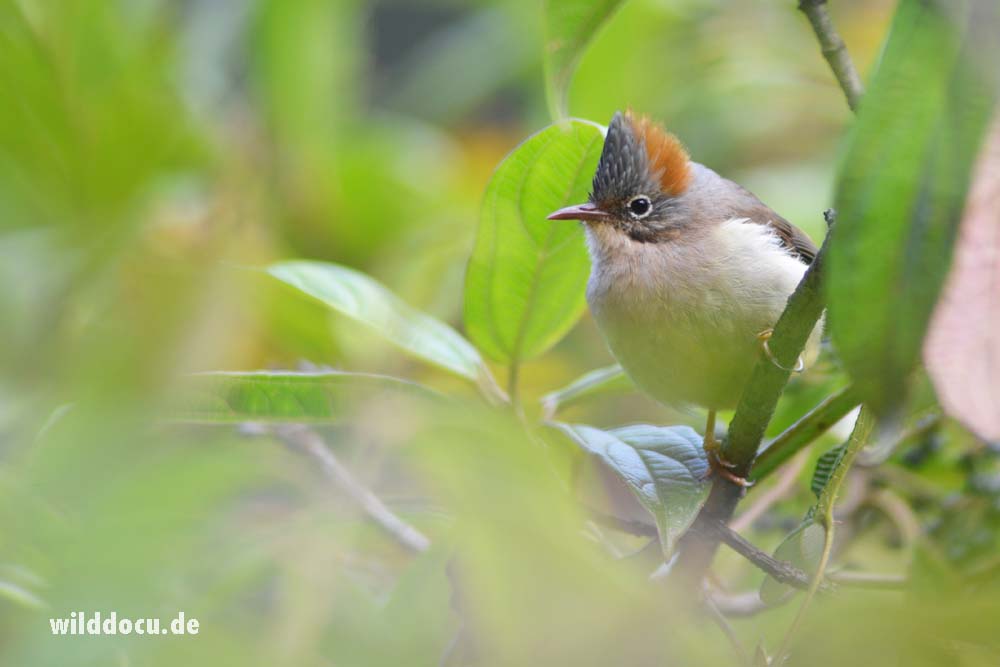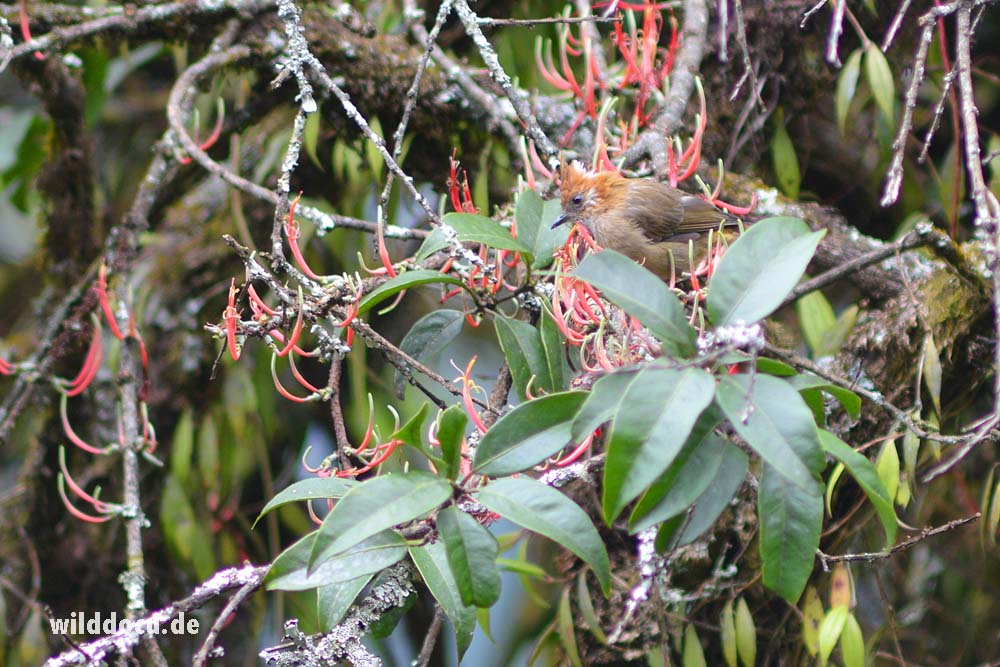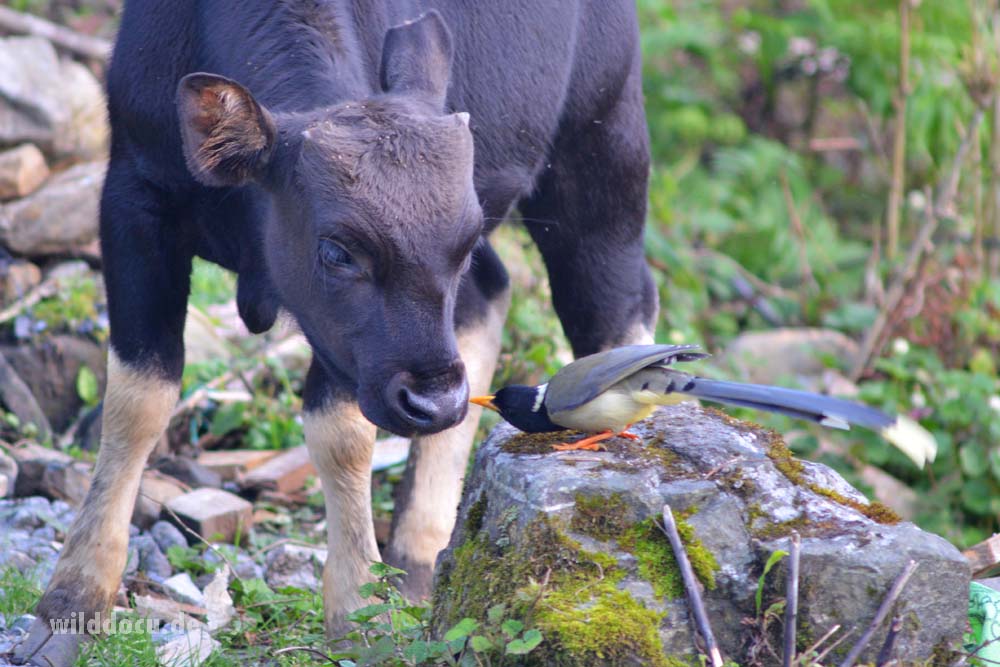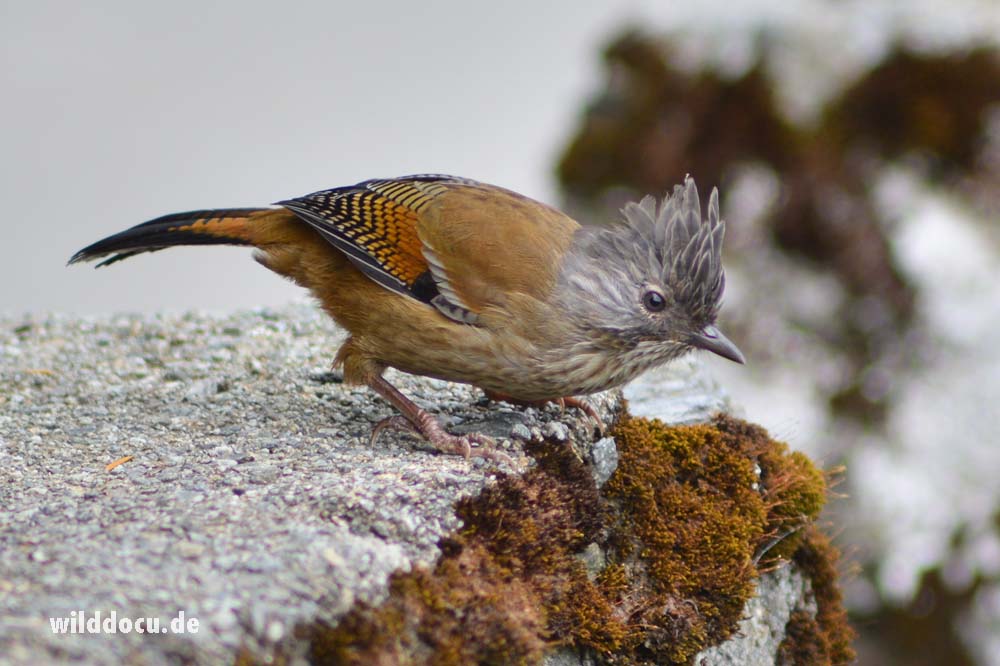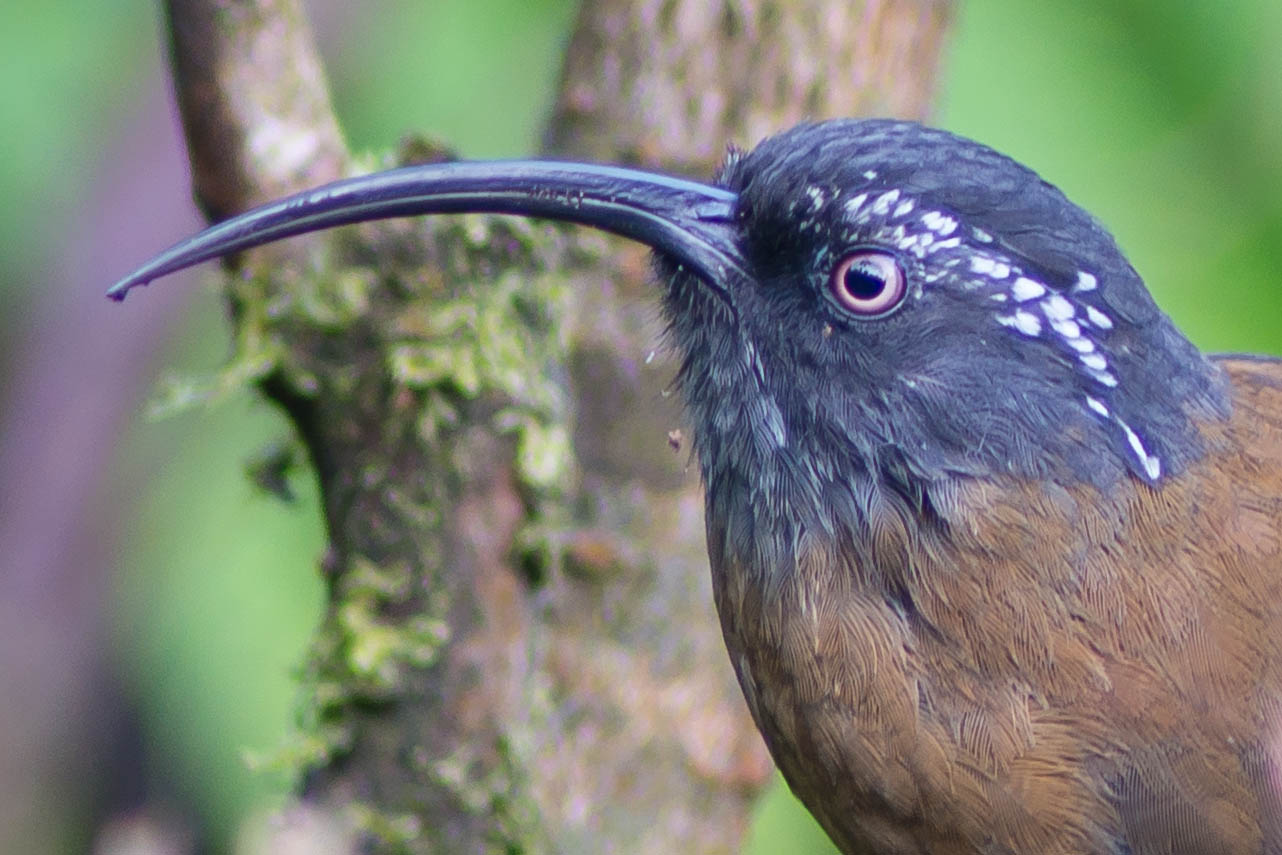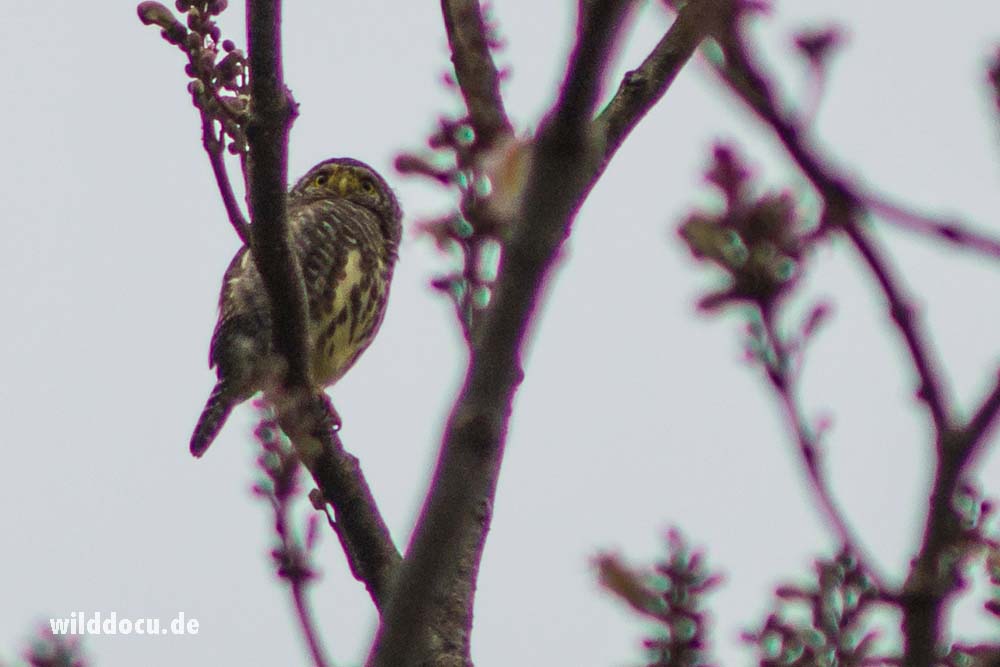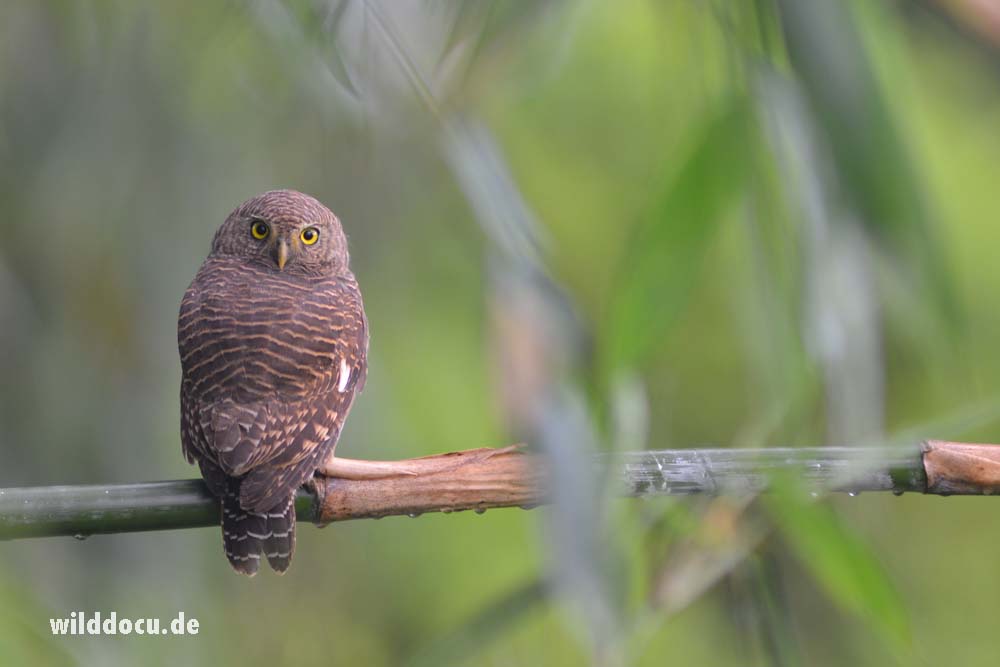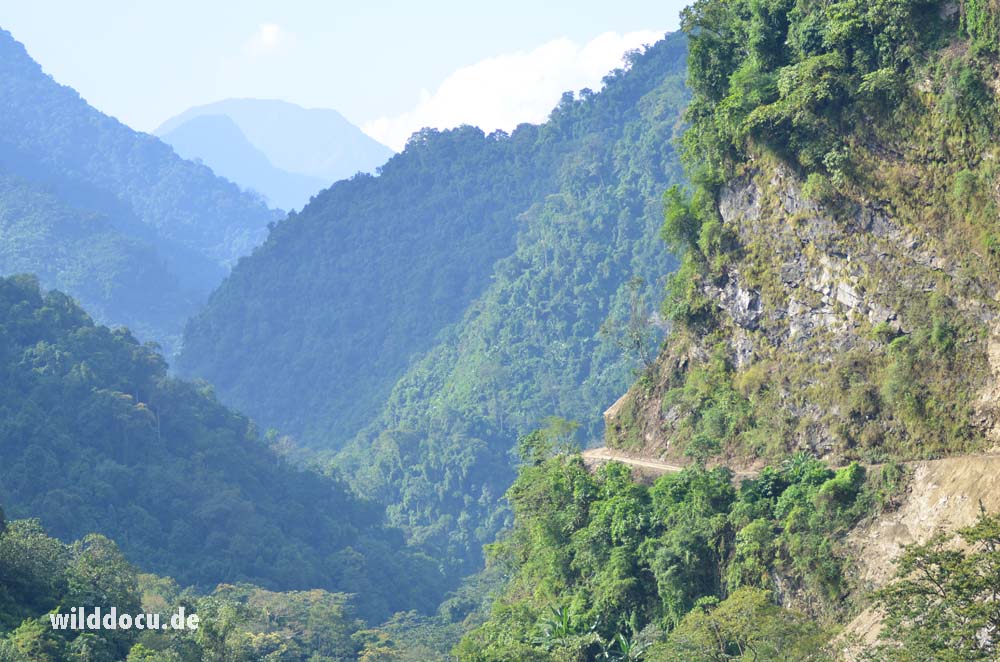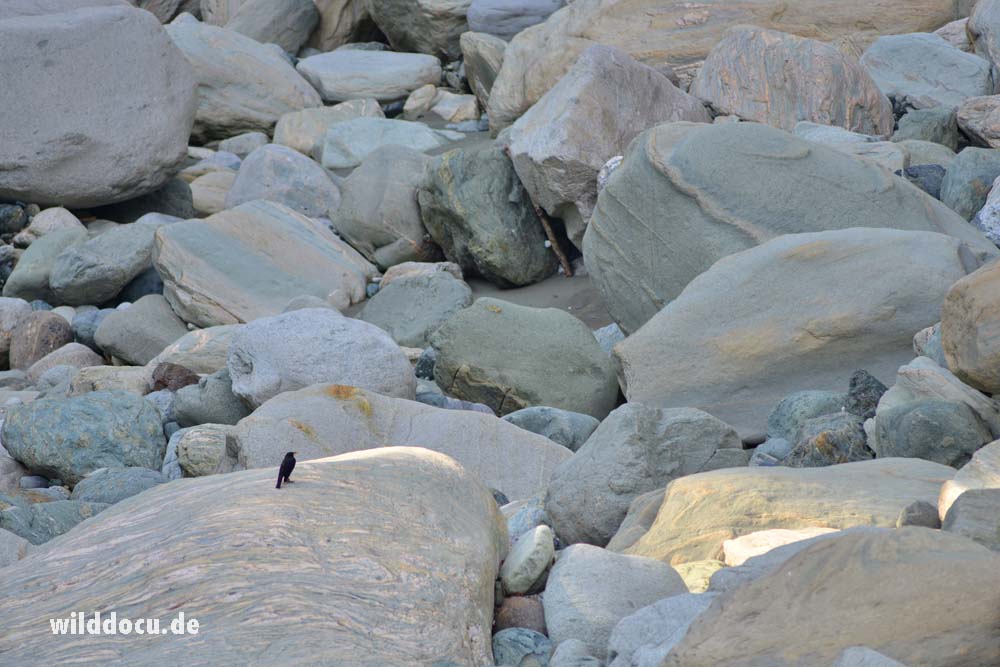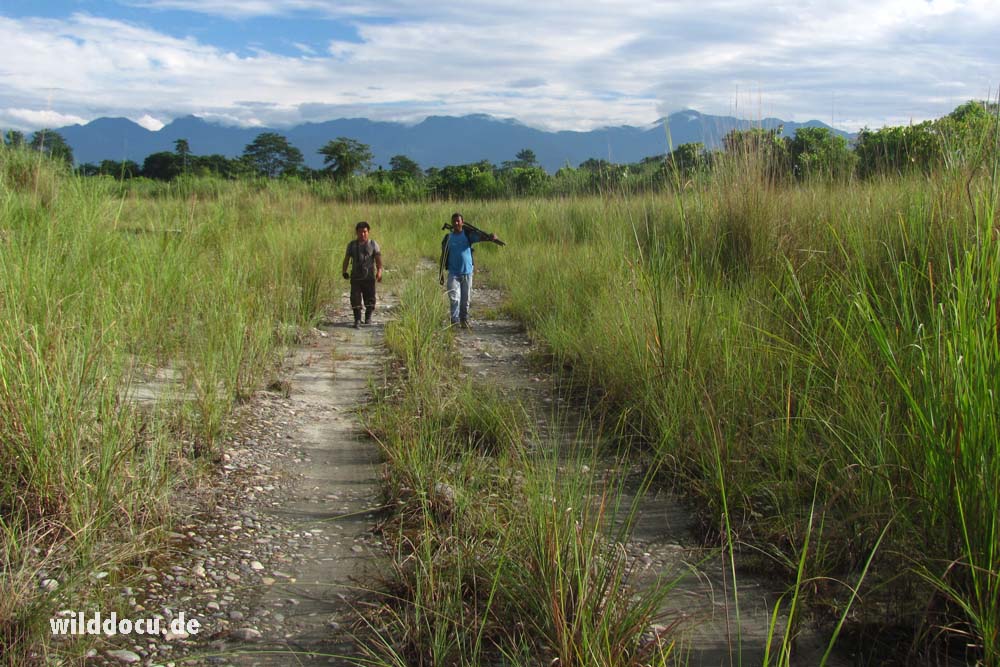Check this illustrated list of birds (70+ species) if you want to find out what you can expect when you go birding in the Mishmi Hills, Arunachal Pradesh, India in the last week of october.
Introduction: Why this kind of report?
Good preparation is a key factor for a successful birding trip. But when you don’t know the area and its birds, reading endless species lists in trip reports with just a few or no photos can be very frustrating. You read, but without using other sources you don’t have a chance to absorb much knowledge.
Furthermore the listing of the total number of bird species for an area – like you find at Avibase – can be frustrating again, especially for an area like the Mishmi Hills, where Avibase (clements, version 2017) indicates the number of species for the Lower Dibang Valley alone with 686 (2017-11). From my experience I can say that a third of the total number of species is very unlikely to be seen during a quick trip through an area – be it attributed to the scarcity or shyness of the birds or because they are vagrants or migratory birds.
What you can expect here
For me illustrated reports are the best way to to get acquainted with the birds of a given areas. This is what I have tried here. The foundation is my week of traveling (Oct. 24th – Oct. 31st) in the Mishmi Hills in 2017. Furthermore: My photographs can give you a hint if my species identification is correct. You can also see how in a relatively unexplored area the physiognomies of birds do differ from the descriptions in the book.
If you want to find out about some of the general information like logistics, guides, accommodation or the mammalian fauna of the area, click here.
Mishmi Hills most wanted
Some of the most wanted birds at the Mishmi Hills that travellers have indicated in their reports are:
Sclater’s Monal, Blyth’s and Temminck’s Tragopan, Wreathed Hornbill, Pale-Headed Woodpecker, Pale-Capped Pigeon, Ward’s Trogon, Dark-Sided Thrush, White-crested and Blue-winged Laughingthrush, Green and Purple Cochoa, Rusty-Bellied and Gould’s Shortwing, Beautiful Nuthatch, Mishmi- and Wedge-Billed Wren-Babbler, Slender-billed Scimitar-Babbler, Green-Tailed Sunbird, Maroon Oriole, Silver-eared Mesia, Himalayan Cutia, Manipur Fulvetta, Fire-Tailed Myzornis, Scarlet- and Grey-Headed Bullfinch.
Some of these birds I did indeed find, but my impression is, that the pressure on the bigger birds in general and the big, ground-dwelling birds in particular like monal and tragopan must be very high. We saw several motorcylists carrying guns on their backs, certainly ready to take it down and shoot what crosses the road infront of them. We never saw these species. An Indian bird guide I talked to, told me that the last time he has seen a Sclater’s Monal in the area was a year ago in November 2016.
My Mishmi Hills birds
The following report is a mix of a chronological series of birds encountered on the trip, site descriptions and compilations of closely related birds.
Sally Lake is our first destination. We go for a short walk in the afternoon. The artificial lake near Roing is a kind of leisure park, where locals go making circles in little plastic boats. Its not really what you expect, when you have lowland subtropical rainforest in mind. The reason why birding groups visit the lake might be that it is one of the few places, where you get easy access to the surrounding lowland forest. Without a concrete path or a road the leech-invested area is basically impenetrable.
Species encountered at Sally Lake are Slaty-backed Forktail, Chestnut-bellied Nuthatch, Grey-backed Shrike, Grey-Headed Woodpecker and a Bronzed Drongo.
Your most common Drongo is the Black Drongo (Dicrurus macrocercus) – at least when you travel towards the Mishmi Hills through the North Indian plains. You find this species in the paddy fields perching and catching insects.
The Bronzed Drongo (Dicrurus aeneus) is the smallest of the Indian Drongos and restricted to moist broadleaved forests.
I see this species again past Mayodia Pass, at the bottom of the Ithun River valley. So maybe it is restricted to lower elevations. Note, how the specimen in the photo below is glossed with metallic blue!
Not far from my first Bronzed Drongo I encounter this close relative on the road to Mayodia Pass: Spangled Drongo. Note: broad tail and long down curved bill
Again on the Ithun River side I observe yet another Drongo species:
On the lower streches of Mayodia Pass road I encounter familiar faces from Europe, first: White Wagtail (Motacilla alba). And a little bit higher up: Grey Wagtail (Motacilla cinerea).
More birds from the lower stretches of Mayodia Pass road:
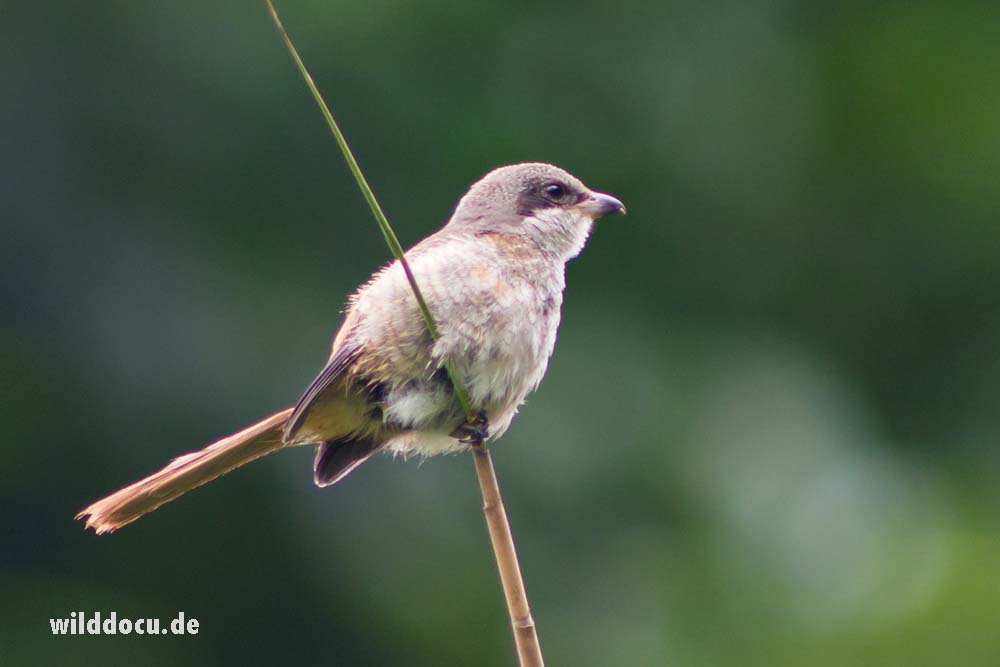
Brown Shrike – probably juvenile male (Lanius cristatus) – Braunwürger – Mayodia-Pass-Road (650 m ASL)
One of the most diverse taxa I found in the Mishmi Hills is that of the Bulbuls. Familiar from the plains are Red-Vented- and Red-Whiskered Bulbul.
Two Minivet species I find in close succession:

Scarlet Minivet – female (Pericrocotus specious) – Scharlachmennigvogel – Mayodia-Pass-Road (850 m ASL)

Grey-Chinned Minivet – male (Pericrocotus solaris) – Graukehl-Mennigvogel – Mayodia-Pass-Road (1377 m ASL)
Flycatchers, I find three species. The most striking is:

Dark-Sided Flycatcher – juvenile (Muscicapa sibirica) – Rußschnäpper – Mayodia-Pass-Road (1377 m ASL)
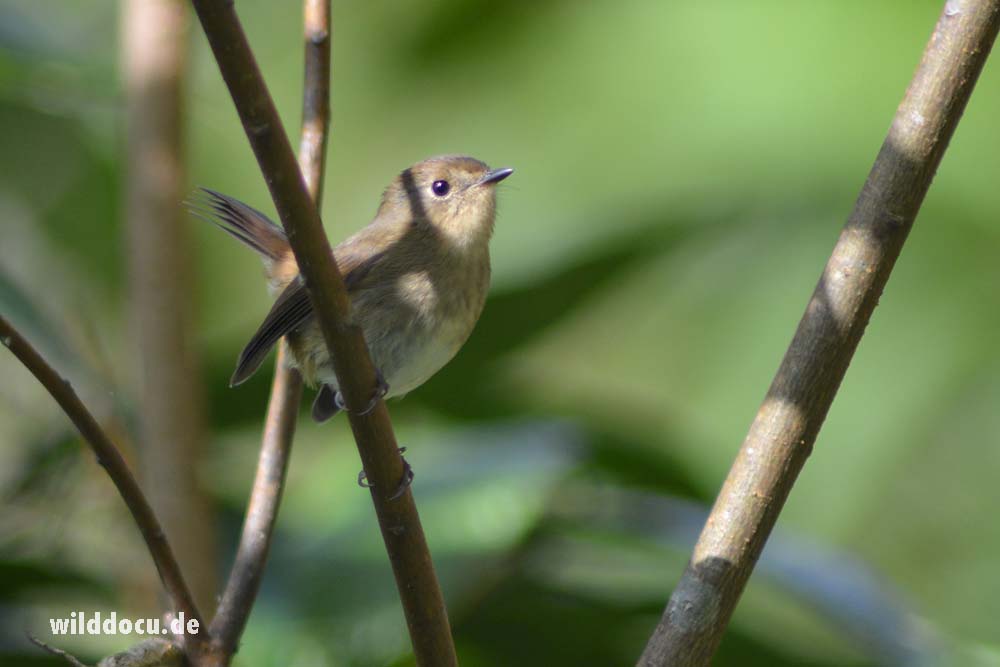
Slaty-Blue Flycatcher? – female (Ficedula tricolor) – Dreifarbenschnäpper – Mishmi-Hills (above 2000 m ASL)
One of the greatest sights of the trip: 18 Wreathed Hornbills in flight. On closer inspection I find out that two of them are males, the other 16 are juveniles (recognizable by their smaller bill). I know of large group compositions in hornbills, but two male adults going on a trip with a bunch of youngsters – what is this?
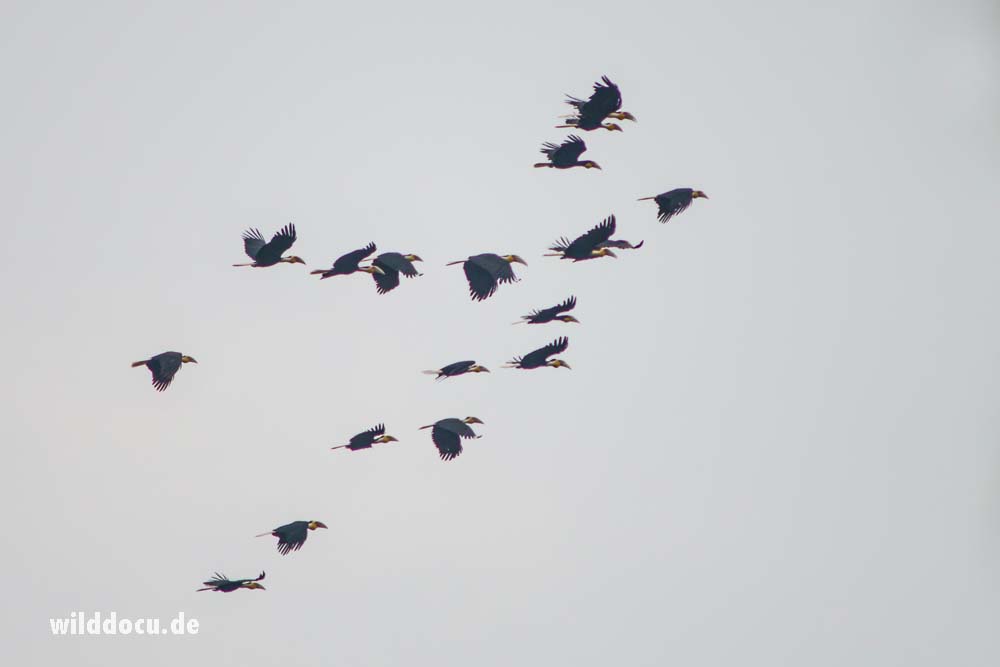
Wreathed Hornbill (Rhyticeros undulatus) – Furchenhornvogel – Mayodia-Pass-Road (birds at ca. 1000 m ASL)
Further up we see another group of five hornbills at great distance:
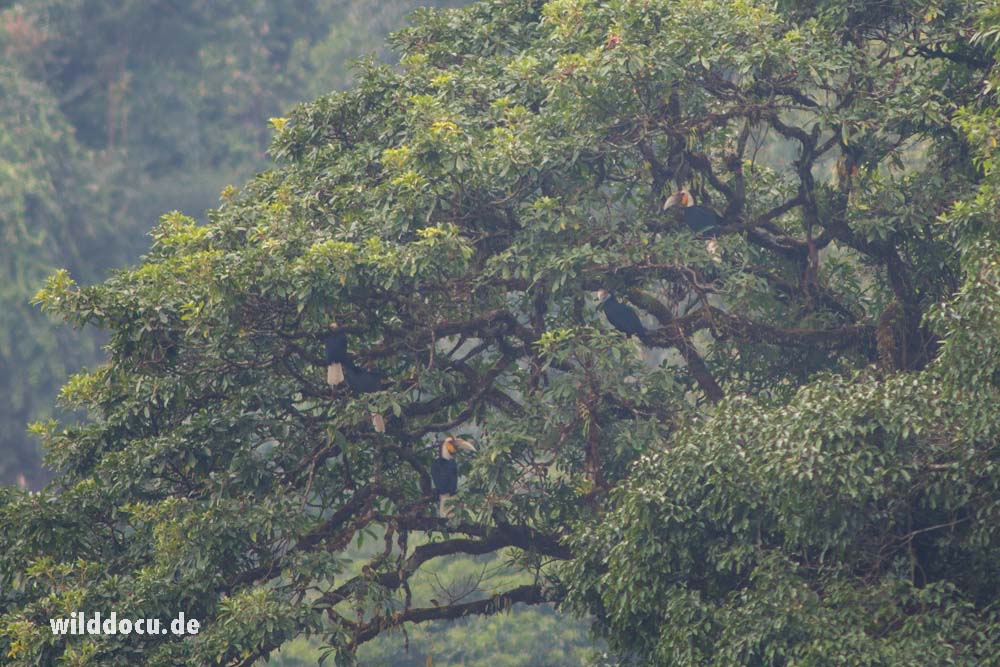
Wreathed Hornbill (Rhyticeros undulatus) – Furchenhornvogel – Mayodia-Pass-Road (birds at ca. 2510 m ASL)
We find fewer woodpeckers than expected – only two species: At 650 m ASL on the way up to Mayodia Pass there is the only known site for Pale-Headed Woodpeckers (Gecinulus grantia). We hear the bird, but don’t see it. Further up we do better:
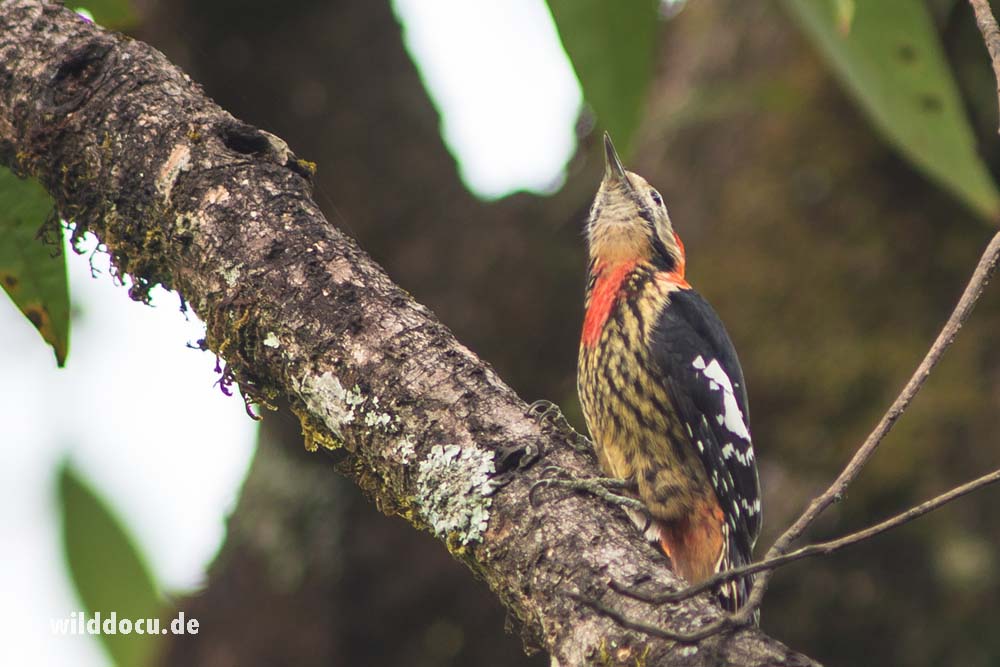
Crimson-Breasted Woodpecker (Dendrocopos cathpharius) – Rotbrustspecht – Mayodia-Pass-Road (2510 m ASL
At 1040 m ASL we hear a White-Crested Laughingthrush (Garrulax leucolophus).
Tits are not very common – I see and photograph only one species:
Frequently observed in the Mishmi Hills:
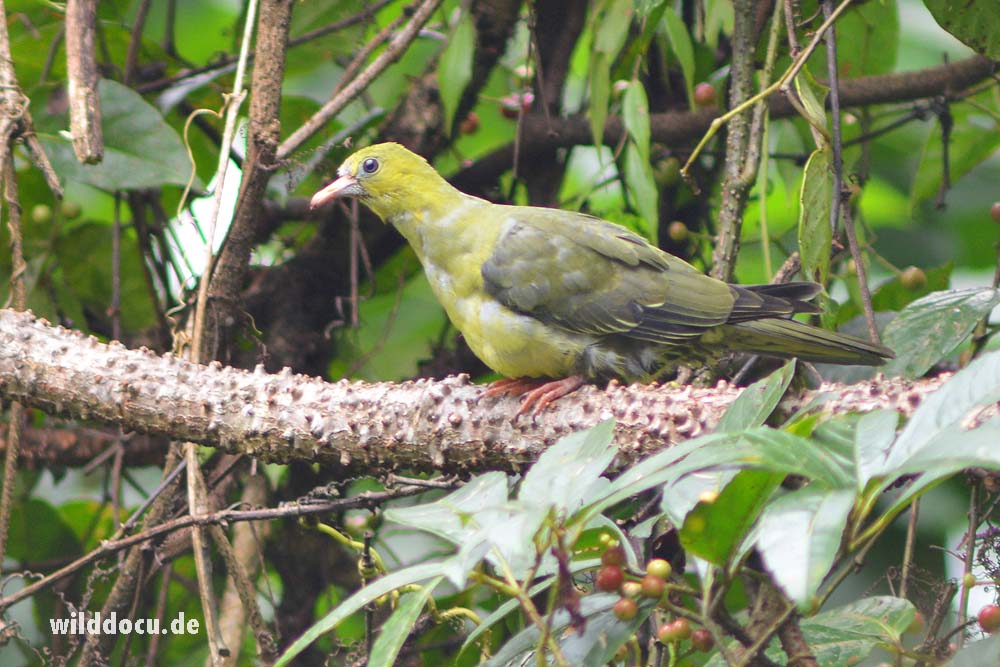
Wedge-Tailed Green Pigeon – female (Treron sphenurus) – Keilschwanz-Grüntaube – Mayodia-Pass-Road (1377 m ASL)
Very nice find – but very shy and with rather untypical appearance: Pale-Capped Pigeon – neither with pale cap, nor with the pale face of juvenils.
Makes „music“ too:
Another raptor we observe – which I do not find easy to identify:
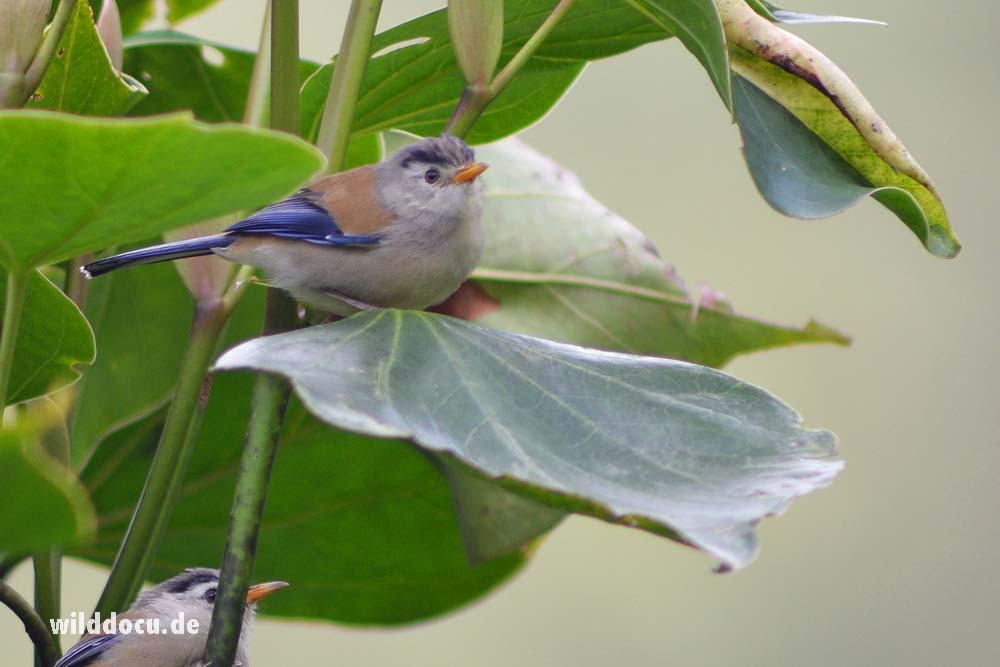
Blue-Winged Siva (Siva cyanouroptera) – Blauflügel-Siva – Mishmi-Hills
At 2510 m ASL I find this flowering tree, which I can not identify. It seems to be very popular with birds.
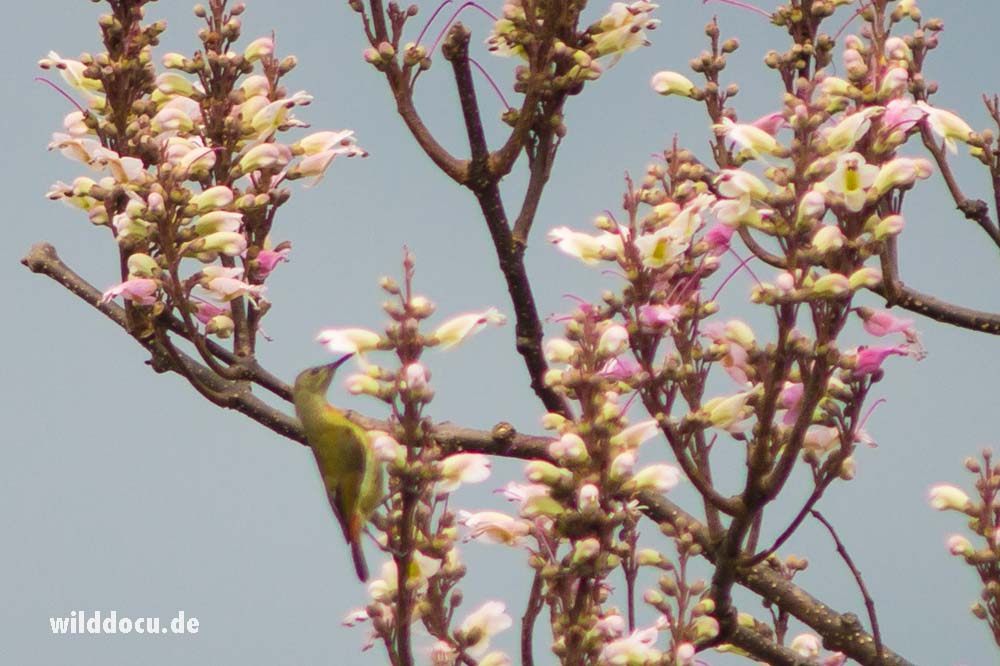
Fire-Tailed Sunbird – eclipse male? (Aethopyga ignicauda) – Feuerschwanz-Nektarvogel – Mayodia-Pass-Road (2510 m ASL)
Other sunbirds:

Black-Throated Sunbird (Aethopyga saturata) – Schwarzkehl-Nektarvogel – Mayodia-Pass-Hunli (1599 m ASL)
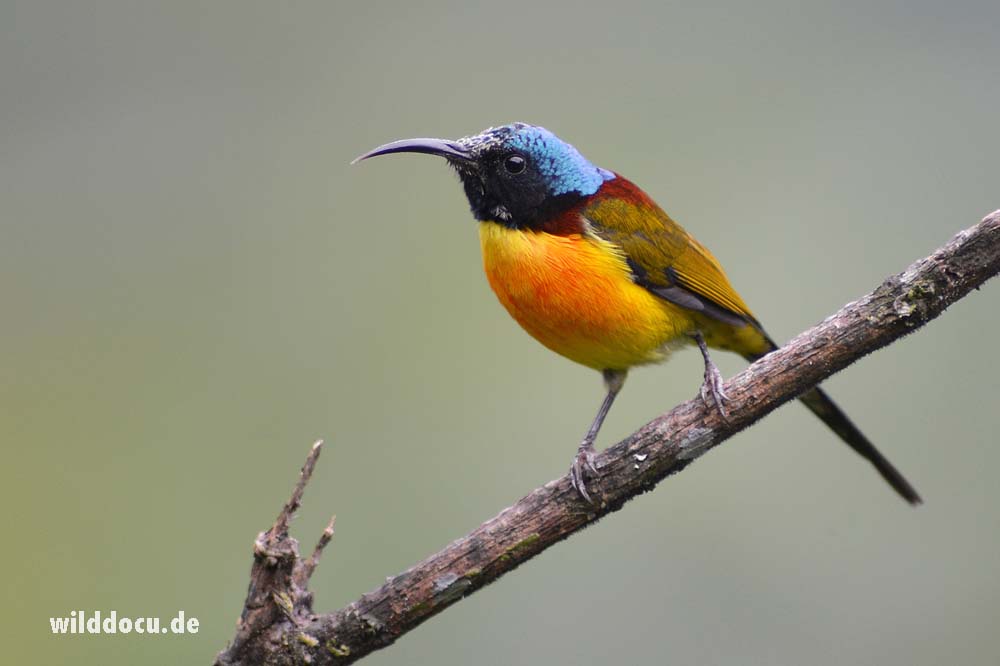
Green-Tailed Sunbird (Aethopyga nipalensis) – Grünschwanz-Nektarvogel – Mayodia-Pass-Roing (1838 m ASL)
A warbler hovering almost like a humming bird!
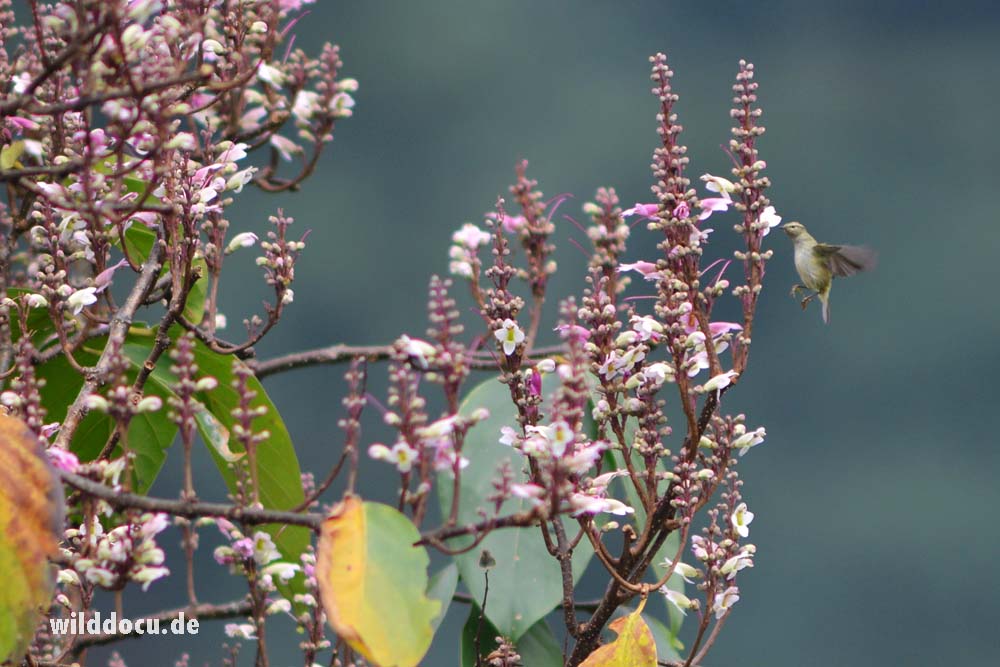
Buff-Barred Warbler? (Phylloscopus pulcher) – Goldbinden-Laubsänger – Mayodia-Pass-Road (2510 m ASL)
In the following photo the buff or golden wing bar is visible, which is indicative of the Buff-Barred Warbler – but doubts remain: supercilium is rather pale and there is not much white on the tail; throat and breast appear grayish as in the Ashy-Throated Warbler.
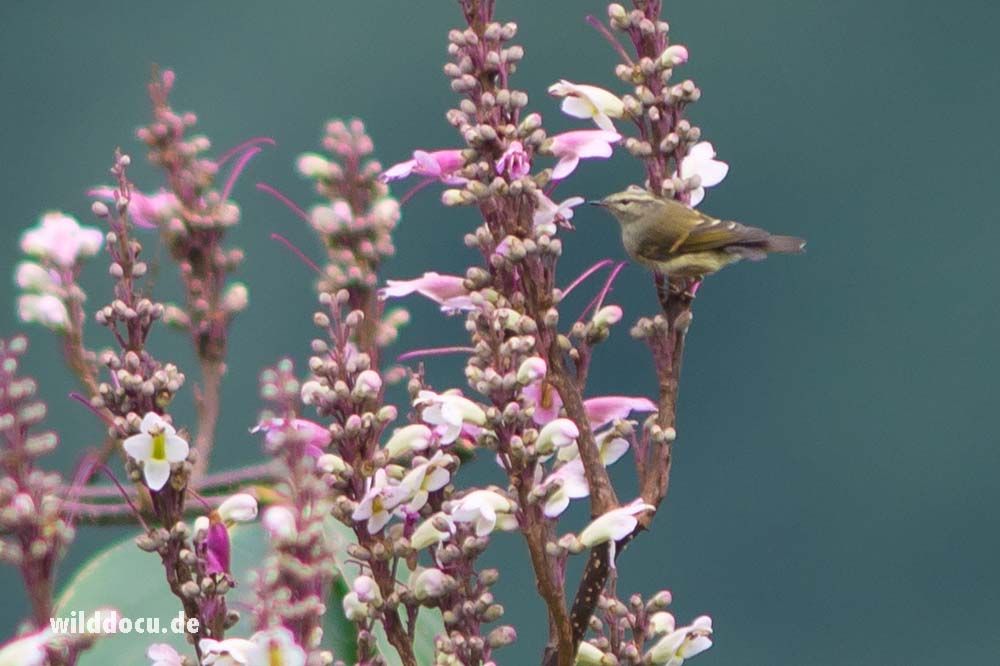
Buff-Barred Warbler? (Phylloscopus pulcher) – Goldbinden-Laubsänger – Mayodia-Pass-Road (2510 m ASL)
More warblers:
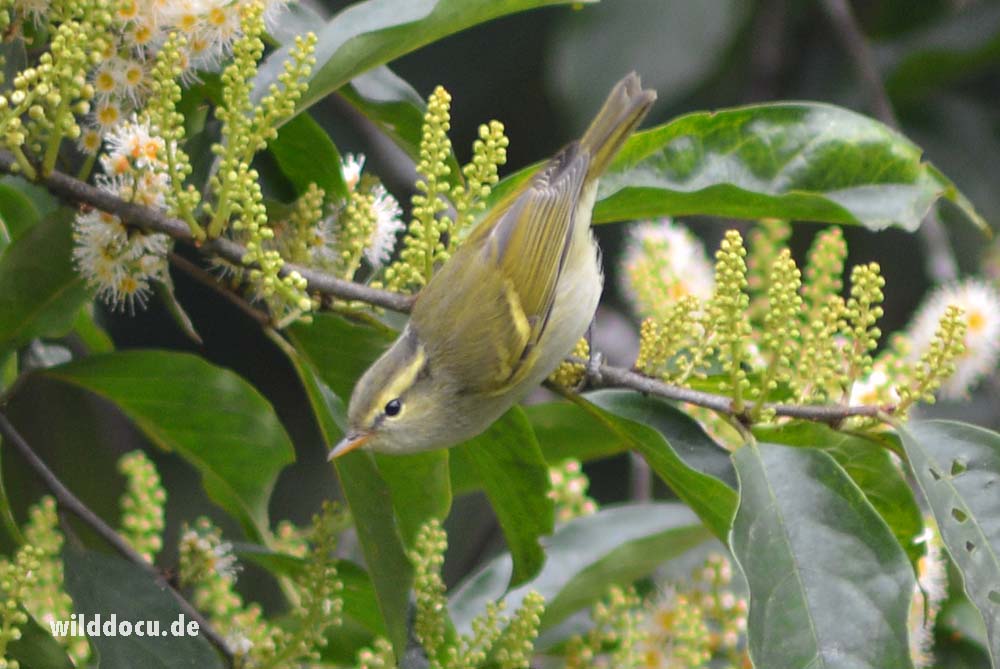
Blyth’s-Leaf Warbler (Phylloscopus reguloides) – Streifenkopf-Laubsänger – Mayodia-Pass-Roing (1834 m ASL)

Whistler’s Warbler? (Seicercus whistleri) – Whistler-Laubsänger – Hunli-Mayodia-Pass (above 2000 m ASL)
At creeks, rivers and cascades look for these birds:
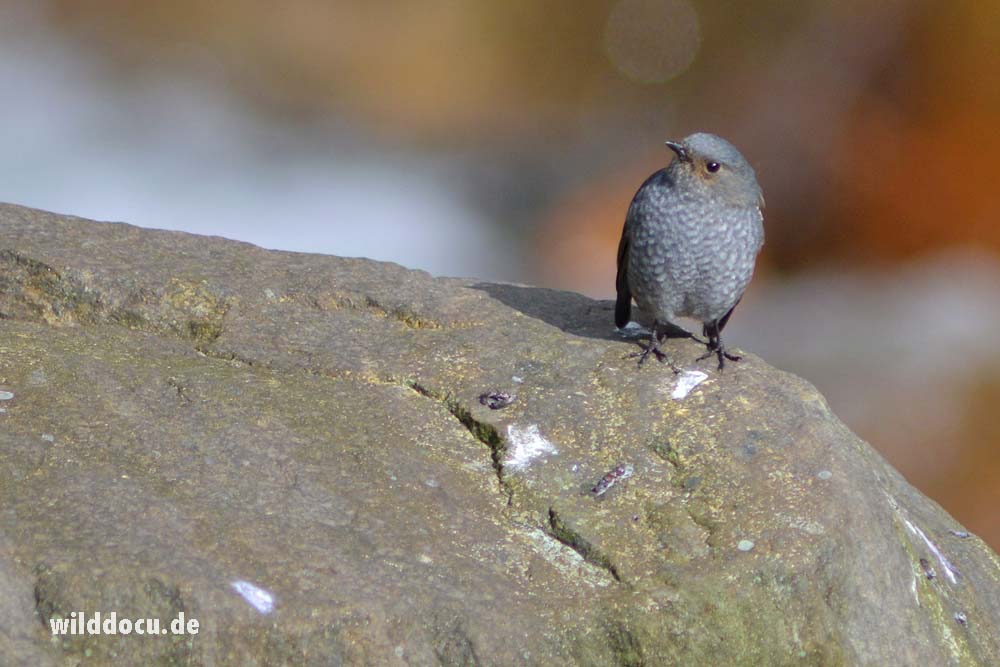
Plumbeous Water Redstart – female (Rhyacornis fuliginosa) – Wasserrotschwanz – Mayodia-Pass-Road (2510 m ASL)

Plumbeous Water Redstart – male (Rhyacornis fuliginosa) – Wasserrotschwanz – Mayodia-Pass-Road (2510 m ASL)
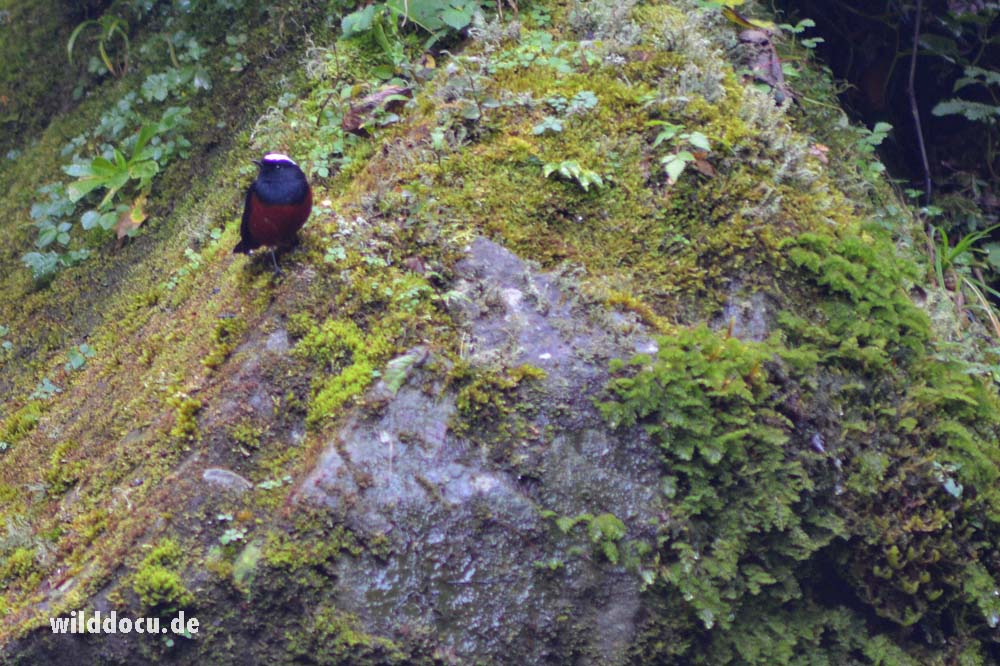
White-Capped Redstart (Chaimarrornis leucocephalus) – Weißkopf-Rotschwanz – Mayodia-Pass-Area (2500 m ASL)
Also associated with streams (and mountain forests) is the genus of the Forktails. As already mentioned, I see the Slaty-Backed Forktail (Enicurus schistaceus) at Sally Lake and a Spotted Forktail (Enicurus maculates) near Hunli at 1515 m ASL.
In the taxon „Fulvetta“ I find three species:
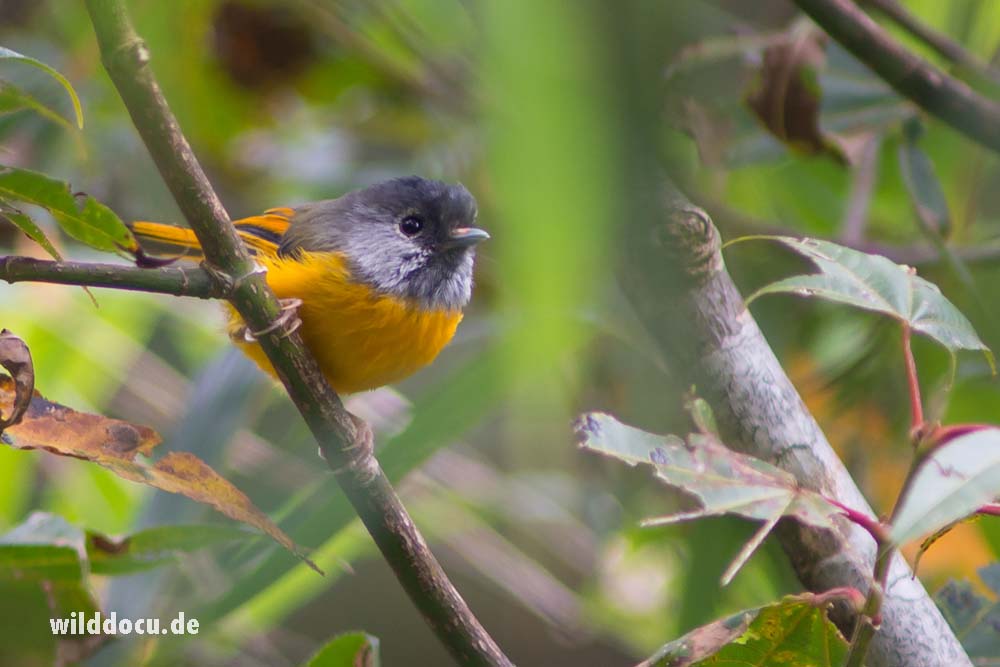
Golden-Breasted Fulvetta (Lioparus chrysotis) – Gold-Alcippe – (near Mayodia Coffee House, 2366 m ASL)
… and one of the highlights of the trip:
I find two species of pipits along the road:
At 2117 m ASL on the way up to the pass you can expect Ward’s Trogon (Harpactes wardi). My guide Drama tries very hard to attract one by playing back Trogon calls. One responds, but it takes maybe 15 minutes before we see a yellow-bellied bird – a female – briefly flying through the canopies. It never comes close. At later occasions we have no response at all.
Maybe the most abundant and diverse group of birds in the Mishmi Hills is the taxon „yuhina“.
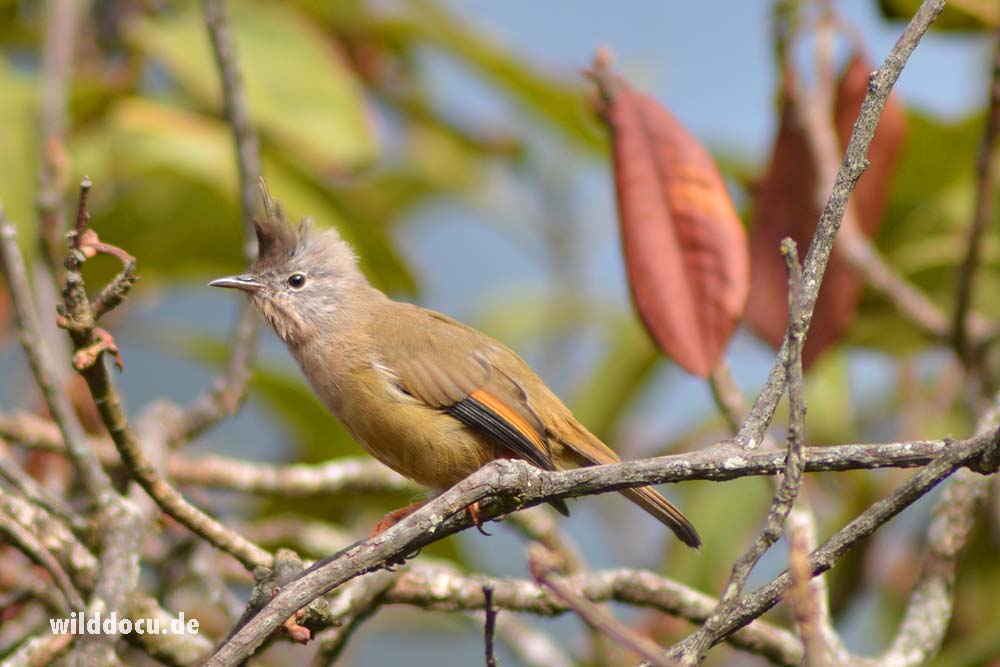
Stripe-throated Yuhina (Yuhina gularis) – Kehlstreifen-Yuhina – Hunli-Mayodia-Pass (above 2000 m ASL)
Mayodia Coffee House is the only place, where I observe Yellow-Billed Blue Magpies (Urocissa flavirostris). I see them repeatedly, calling in in small flocks. The first encounter is the best with this Mithun calf being examined – most probably – for parasites. I can actually see how the calf invites the bird to check its nostrils by stretching its head towards the magpie.
Among the birds you can expect around Mayodia-Pass is this one:
On the Roing-side of the pass, we see this great bird:
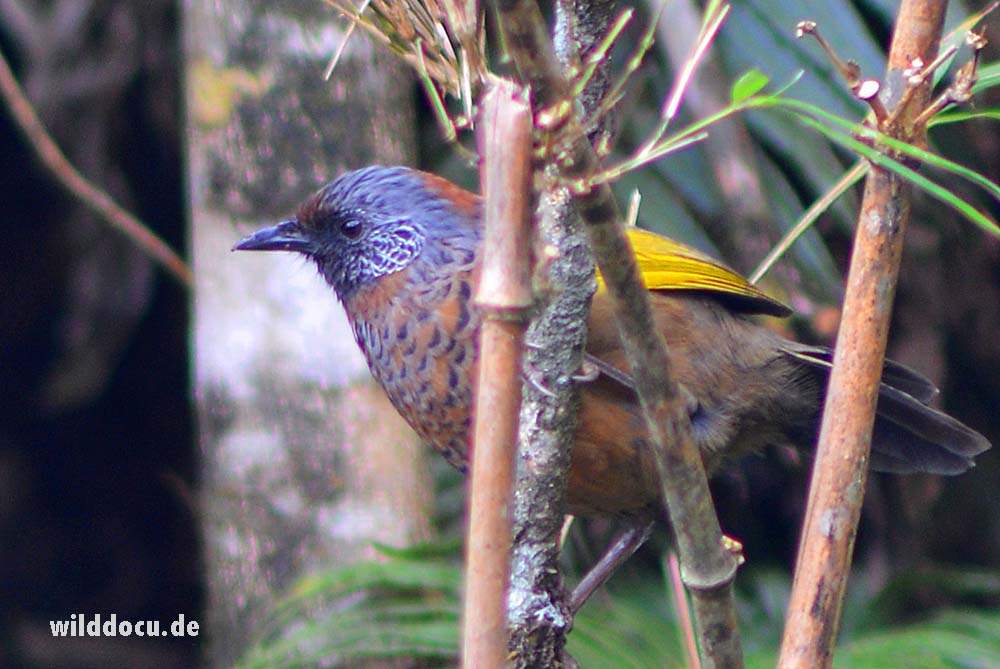
Chestnut-Crowned Laughingthrush (Garrulax erythrocephalus) – Rotscheitel-Häherling – below Mayodia Pass on the Roing side (2366 m ASL)
On the Hunli-side of the pass we encounter this beauty: Streak-Throated Barwing. But again it is rather untypical in appearance: The underparts are grayish as in the subspecies Actinodura waldeni daflaensis, but the crown is grayish-white instead of brownish.
Others „pass birds“ are: Hill Partridge (Arborophila torqueola), which we frequently hear, but fail to see and Common Hoopoe (Upupa epos). We try several times for Sclater’s Monal (Lophophorus sclateri) in an open area a few hundred meters behind the pass (Hunli side), but always fail.
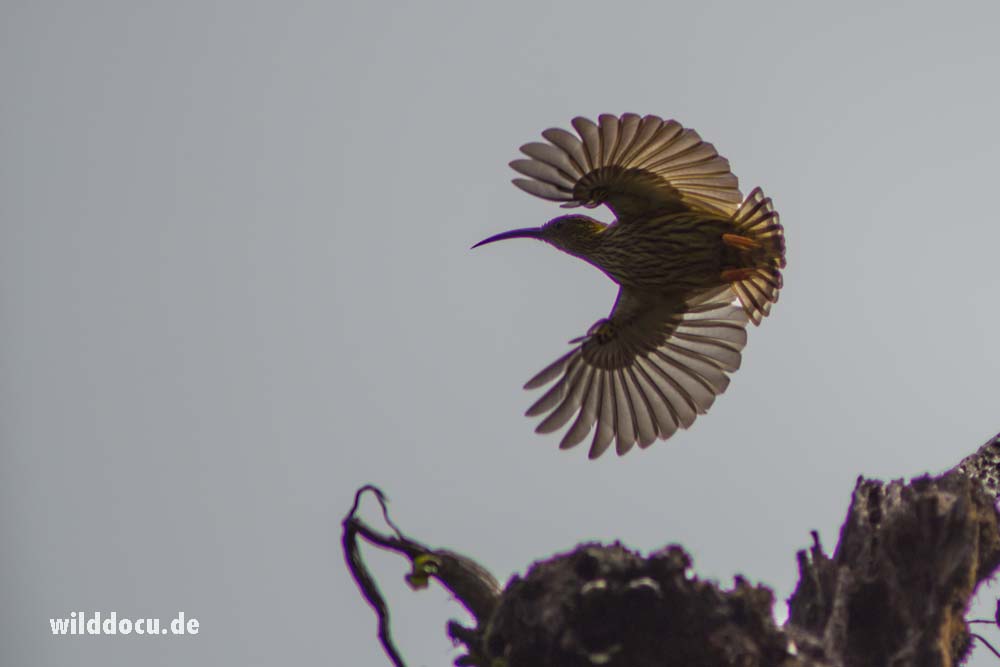
Streaked Spiderhunter (Arachnothera magna) – Strichelspinnenjäger – Hunli-Mayodia-Pass (above 2000 m ASL)
For me the „best bird“ of the trip:
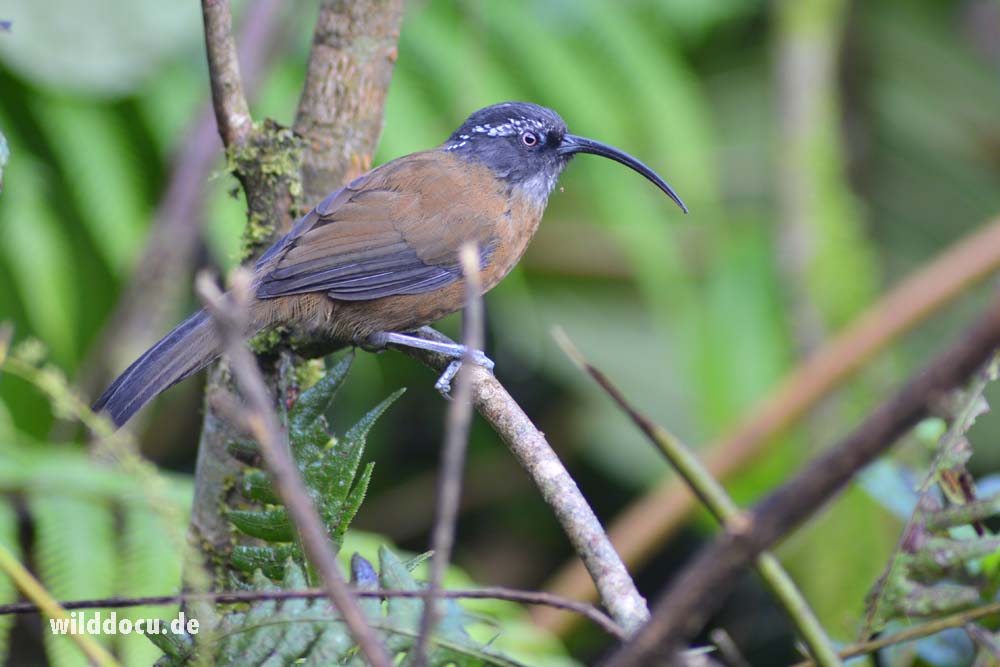
Slender Billed Scimitar Babbler (Xiphirhynchus superciliaris) – Dünnschnabelsäbler – Mayodia-Pass-Hunli (1599 m ASL)
Among the owls we first attract this Collared Owlet.
Another owlet. This one from the plains, at the base of Mishmi Hills:
At Mayodia Coffee House we flush a medium-sized owl on the roadside during a night drive. We see it only briefly, but most conspicuous is the strongly contrasting facial pattern. Therefore I believe it is Brown Wood Owl (Strix leptogrammica).
During the same night drive we spot this nightjar in the Mayodia Pass area. According to local guides and the distribution map it is a Grey Nightjar (Caprimulgus jotaka). But the visible area in the range of head and breast is rather light-colored. This is rather indicative of a Jungle Nightjar (Caprimulgus indicus), which – according to Grimmett et al. (2011) – does not occur in the area.
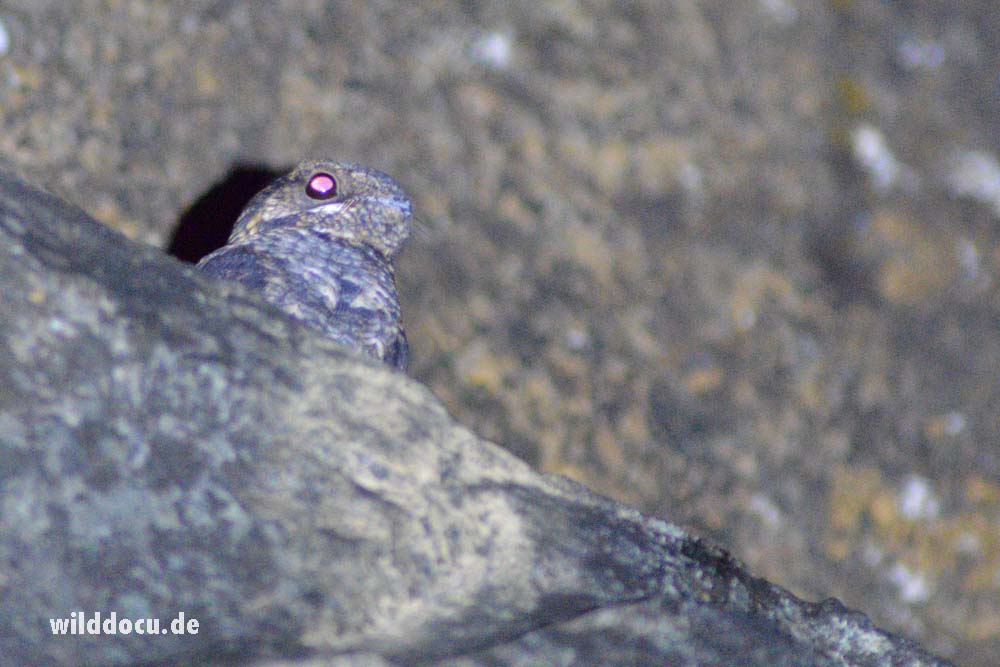
Grey Nightjar? (Caprimulgus (indicus) jotaka) – Grau-Nachtschwalbe – Hunli-Mayodia-Pass (above 2000 m ASL)
Past Hunli, the Ithun River Valley, is also great for birding.
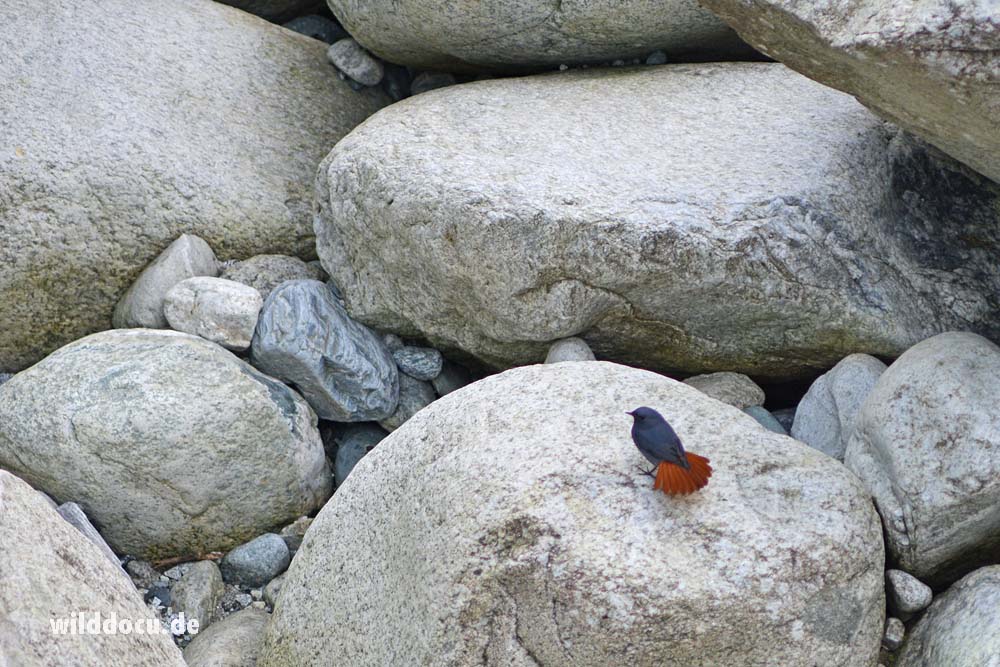
Plumbeous Water Redstart – male (Rhyacornis fuliginosa) – Wasserrotschwanz – Ithun-River (550 m ASL)
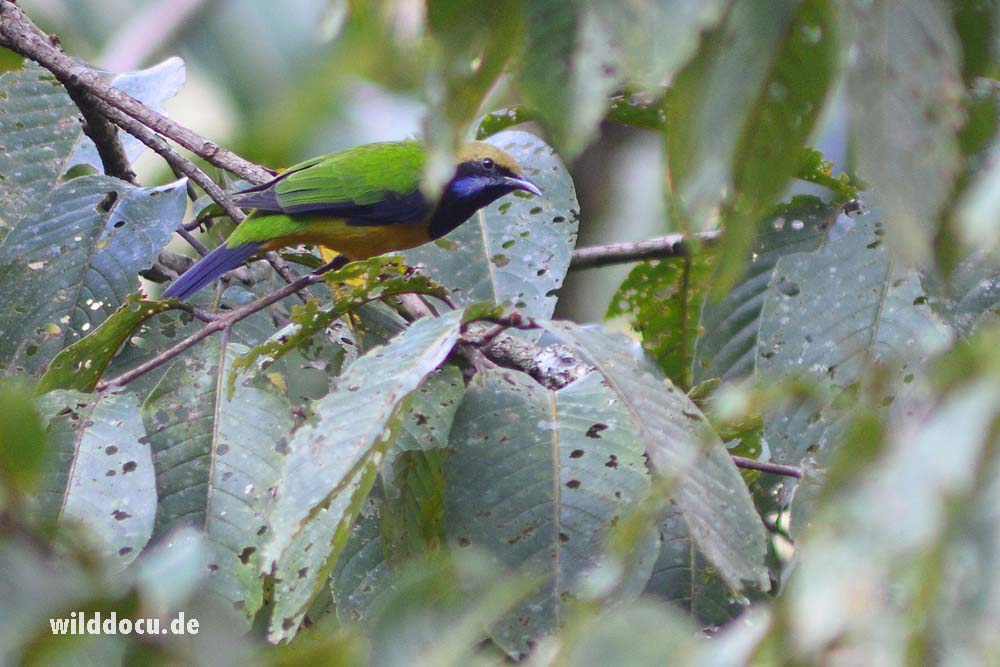
Orange-Bellied Leafbird (Chloropsis hardwickii) – Orangebauch-Blattvogel – Ithun-River Valley (600 m ASL)
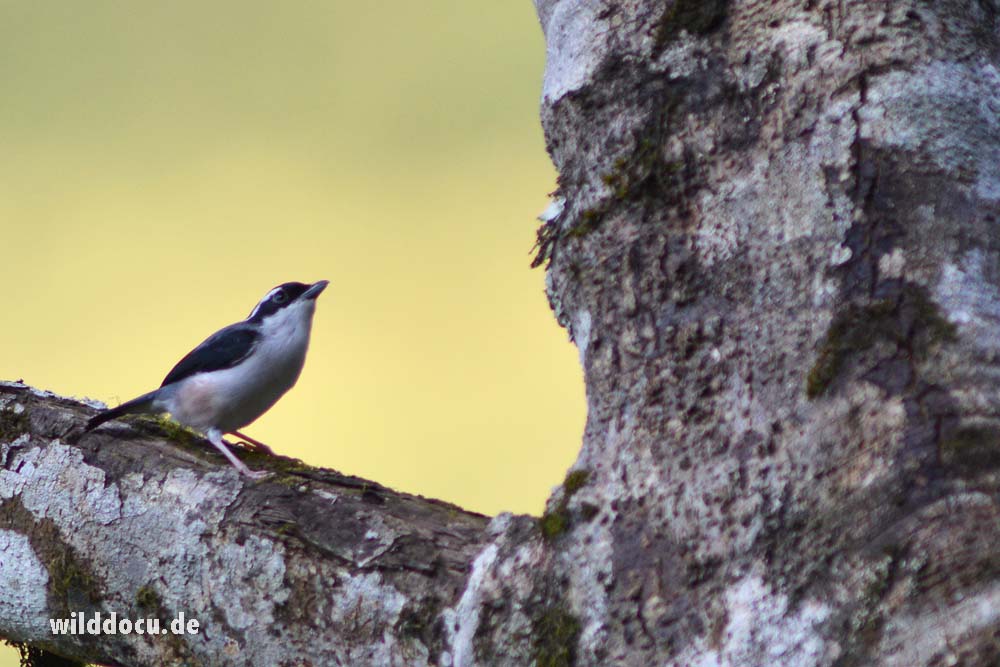
White-Browed Shrike-Babbler (Pteruthius flaviscapis) – Weißbrauen–Würgertimalie – Ithun-River Valley (600 m ASL)
Other birds from the Ithun River Valley are Black-chinnend Yuhina (Yuhina nigrimenta) and Common Green Magpie (Cissa chinensis). In this bird I find the lower end of the wing reddish instead of brownish.
At the end of the trip we visit the reed beds at Idili at the base of the Mishmi Hills to look for parrotbills:
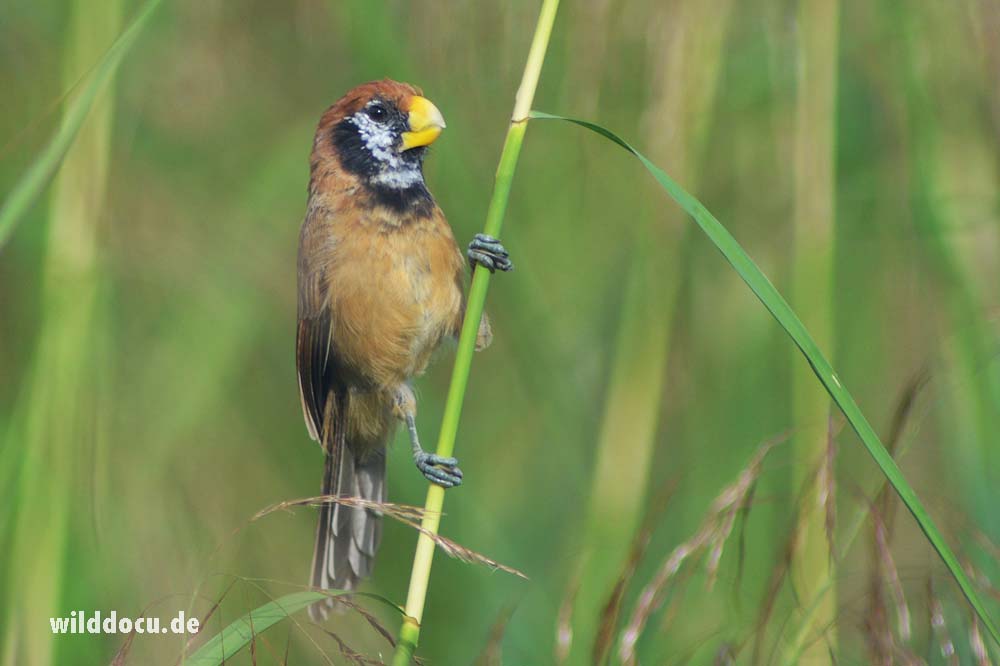
Black-Breasted Parrotbill (Paradoxornis flavirostris) – Schwarzkehl-Papageimeise – Idili (150 m ASL)
Sources
Grimmett, R.; Inskipp, C.; Inskipp, T., 2011: Birds of the Indian Subcontinent. Helm Field Guides, London.

